Leadership and Management Skills in Oil and Gas Industry: Deepwater Horizon Disaster of 2010
VerifiedAdded on 2023/06/15
|21
|7860
|268
AI Summary
This report discusses the Deepwater Horizon Disaster of 2010 and highlights the causes of oil spills, implications on decision making, organizational structure, and communication. It also discusses the role of ethical leadership in avoiding such disasters and provides a detailed explanation of effective leadership styles, principles, business ethics, and organizational behavior.
Contribute Materials
Your contribution can guide someone’s learning journey. Share your
documents today.
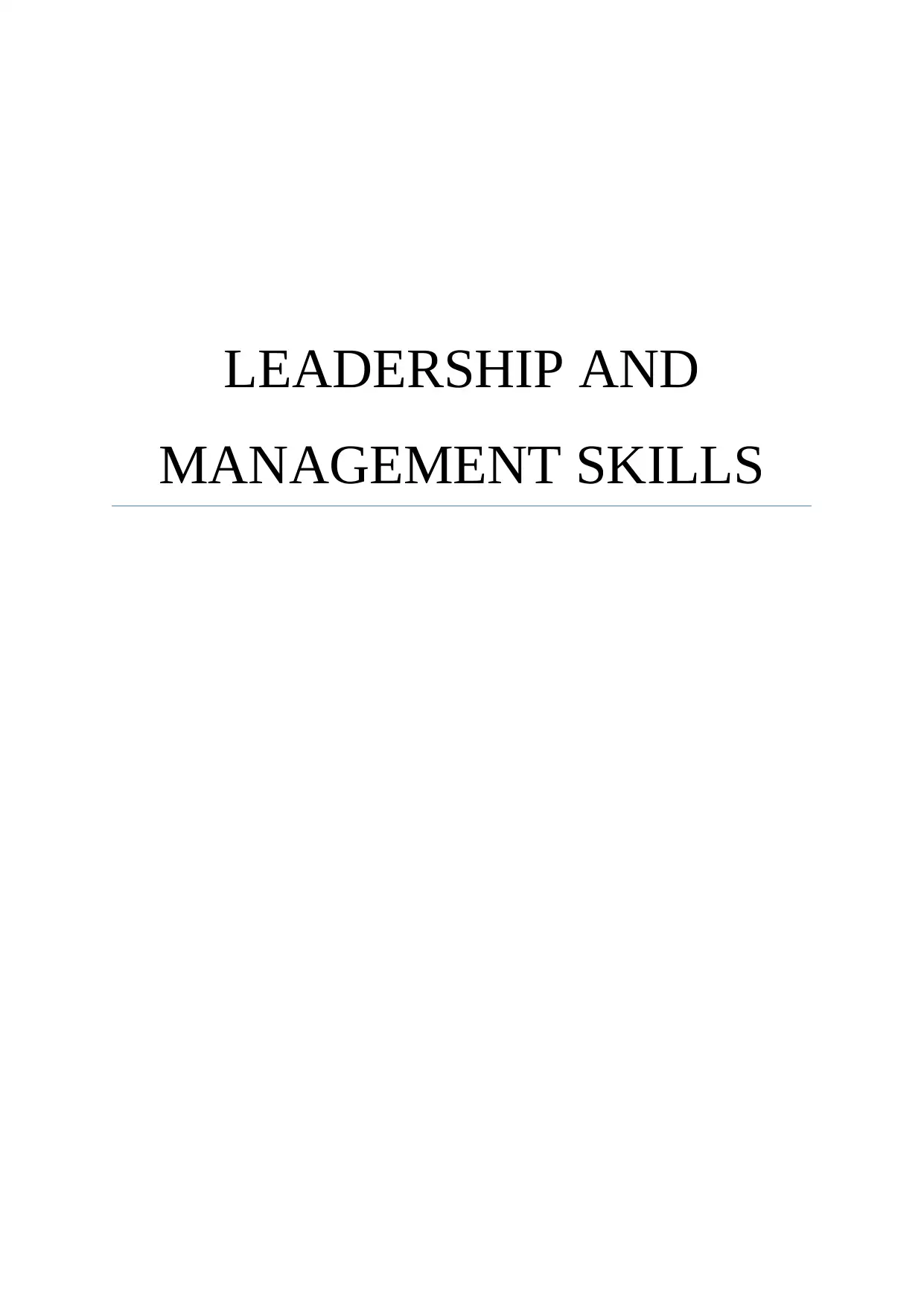
LEADERSHIP AND
MANAGEMENT SKILLS
MANAGEMENT SKILLS
Secure Best Marks with AI Grader
Need help grading? Try our AI Grader for instant feedback on your assignments.
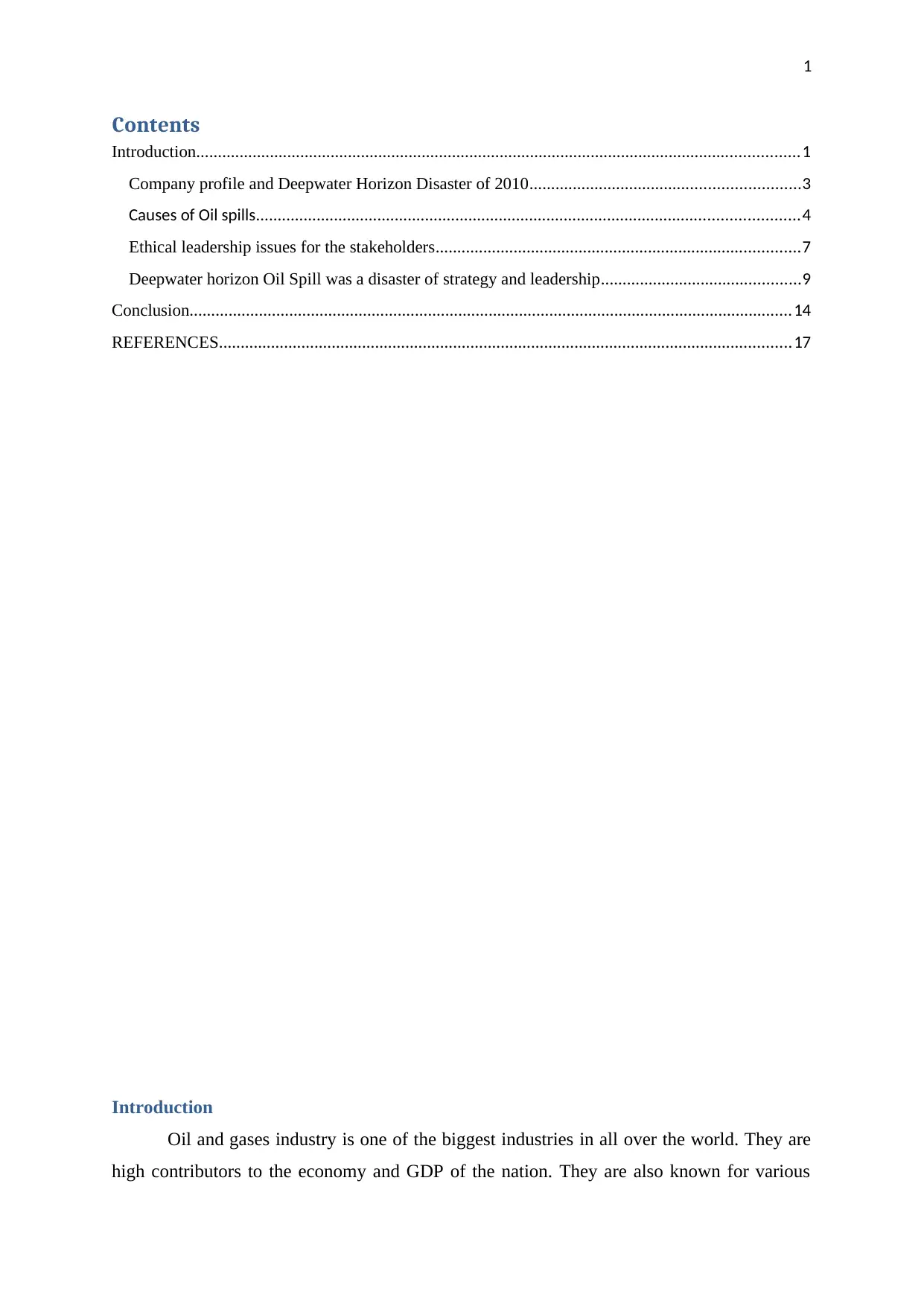
1
Contents
Introduction...........................................................................................................................................1
Company profile and Deepwater Horizon Disaster of 2010..............................................................3
Causes of Oil spills.............................................................................................................................4
Ethical leadership issues for the stakeholders....................................................................................7
Deepwater horizon Oil Spill was a disaster of strategy and leadership..............................................9
Conclusion...........................................................................................................................................14
REFERENCES....................................................................................................................................17
Introduction
Oil and gases industry is one of the biggest industries in all over the world. They are
high contributors to the economy and GDP of the nation. They are also known for various
Contents
Introduction...........................................................................................................................................1
Company profile and Deepwater Horizon Disaster of 2010..............................................................3
Causes of Oil spills.............................................................................................................................4
Ethical leadership issues for the stakeholders....................................................................................7
Deepwater horizon Oil Spill was a disaster of strategy and leadership..............................................9
Conclusion...........................................................................................................................................14
REFERENCES....................................................................................................................................17
Introduction
Oil and gases industry is one of the biggest industries in all over the world. They are
high contributors to the economy and GDP of the nation. They are also known for various
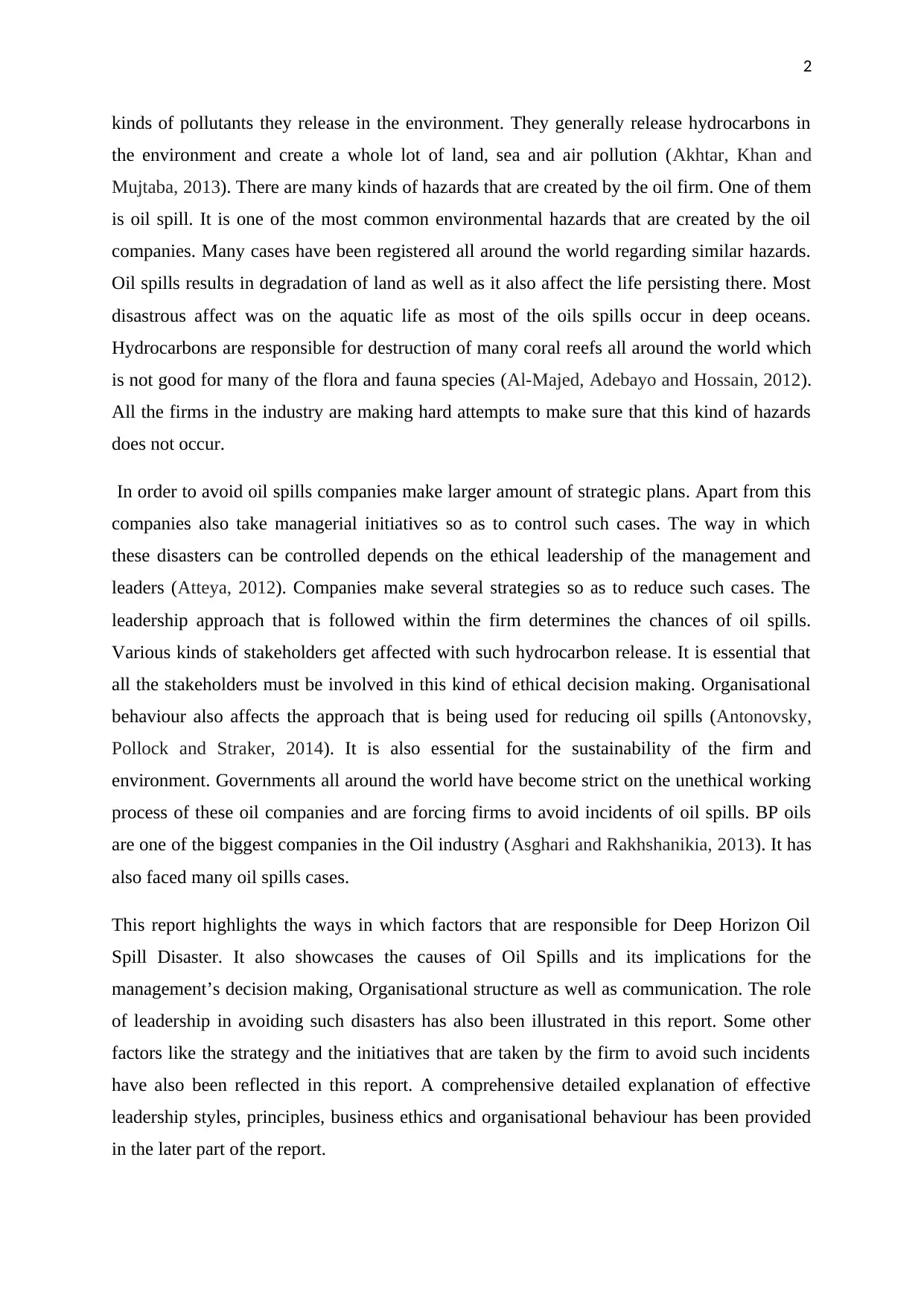
2
kinds of pollutants they release in the environment. They generally release hydrocarbons in
the environment and create a whole lot of land, sea and air pollution (Akhtar, Khan and
Mujtaba, 2013). There are many kinds of hazards that are created by the oil firm. One of them
is oil spill. It is one of the most common environmental hazards that are created by the oil
companies. Many cases have been registered all around the world regarding similar hazards.
Oil spills results in degradation of land as well as it also affect the life persisting there. Most
disastrous affect was on the aquatic life as most of the oils spills occur in deep oceans.
Hydrocarbons are responsible for destruction of many coral reefs all around the world which
is not good for many of the flora and fauna species (Al-Majed, Adebayo and Hossain, 2012).
All the firms in the industry are making hard attempts to make sure that this kind of hazards
does not occur.
In order to avoid oil spills companies make larger amount of strategic plans. Apart from this
companies also take managerial initiatives so as to control such cases. The way in which
these disasters can be controlled depends on the ethical leadership of the management and
leaders (Atteya, 2012). Companies make several strategies so as to reduce such cases. The
leadership approach that is followed within the firm determines the chances of oil spills.
Various kinds of stakeholders get affected with such hydrocarbon release. It is essential that
all the stakeholders must be involved in this kind of ethical decision making. Organisational
behaviour also affects the approach that is being used for reducing oil spills (Antonovsky,
Pollock and Straker, 2014). It is also essential for the sustainability of the firm and
environment. Governments all around the world have become strict on the unethical working
process of these oil companies and are forcing firms to avoid incidents of oil spills. BP oils
are one of the biggest companies in the Oil industry (Asghari and Rakhshanikia, 2013). It has
also faced many oil spills cases.
This report highlights the ways in which factors that are responsible for Deep Horizon Oil
Spill Disaster. It also showcases the causes of Oil Spills and its implications for the
management’s decision making, Organisational structure as well as communication. The role
of leadership in avoiding such disasters has also been illustrated in this report. Some other
factors like the strategy and the initiatives that are taken by the firm to avoid such incidents
have also been reflected in this report. A comprehensive detailed explanation of effective
leadership styles, principles, business ethics and organisational behaviour has been provided
in the later part of the report.
kinds of pollutants they release in the environment. They generally release hydrocarbons in
the environment and create a whole lot of land, sea and air pollution (Akhtar, Khan and
Mujtaba, 2013). There are many kinds of hazards that are created by the oil firm. One of them
is oil spill. It is one of the most common environmental hazards that are created by the oil
companies. Many cases have been registered all around the world regarding similar hazards.
Oil spills results in degradation of land as well as it also affect the life persisting there. Most
disastrous affect was on the aquatic life as most of the oils spills occur in deep oceans.
Hydrocarbons are responsible for destruction of many coral reefs all around the world which
is not good for many of the flora and fauna species (Al-Majed, Adebayo and Hossain, 2012).
All the firms in the industry are making hard attempts to make sure that this kind of hazards
does not occur.
In order to avoid oil spills companies make larger amount of strategic plans. Apart from this
companies also take managerial initiatives so as to control such cases. The way in which
these disasters can be controlled depends on the ethical leadership of the management and
leaders (Atteya, 2012). Companies make several strategies so as to reduce such cases. The
leadership approach that is followed within the firm determines the chances of oil spills.
Various kinds of stakeholders get affected with such hydrocarbon release. It is essential that
all the stakeholders must be involved in this kind of ethical decision making. Organisational
behaviour also affects the approach that is being used for reducing oil spills (Antonovsky,
Pollock and Straker, 2014). It is also essential for the sustainability of the firm and
environment. Governments all around the world have become strict on the unethical working
process of these oil companies and are forcing firms to avoid incidents of oil spills. BP oils
are one of the biggest companies in the Oil industry (Asghari and Rakhshanikia, 2013). It has
also faced many oil spills cases.
This report highlights the ways in which factors that are responsible for Deep Horizon Oil
Spill Disaster. It also showcases the causes of Oil Spills and its implications for the
management’s decision making, Organisational structure as well as communication. The role
of leadership in avoiding such disasters has also been illustrated in this report. Some other
factors like the strategy and the initiatives that are taken by the firm to avoid such incidents
have also been reflected in this report. A comprehensive detailed explanation of effective
leadership styles, principles, business ethics and organisational behaviour has been provided
in the later part of the report.
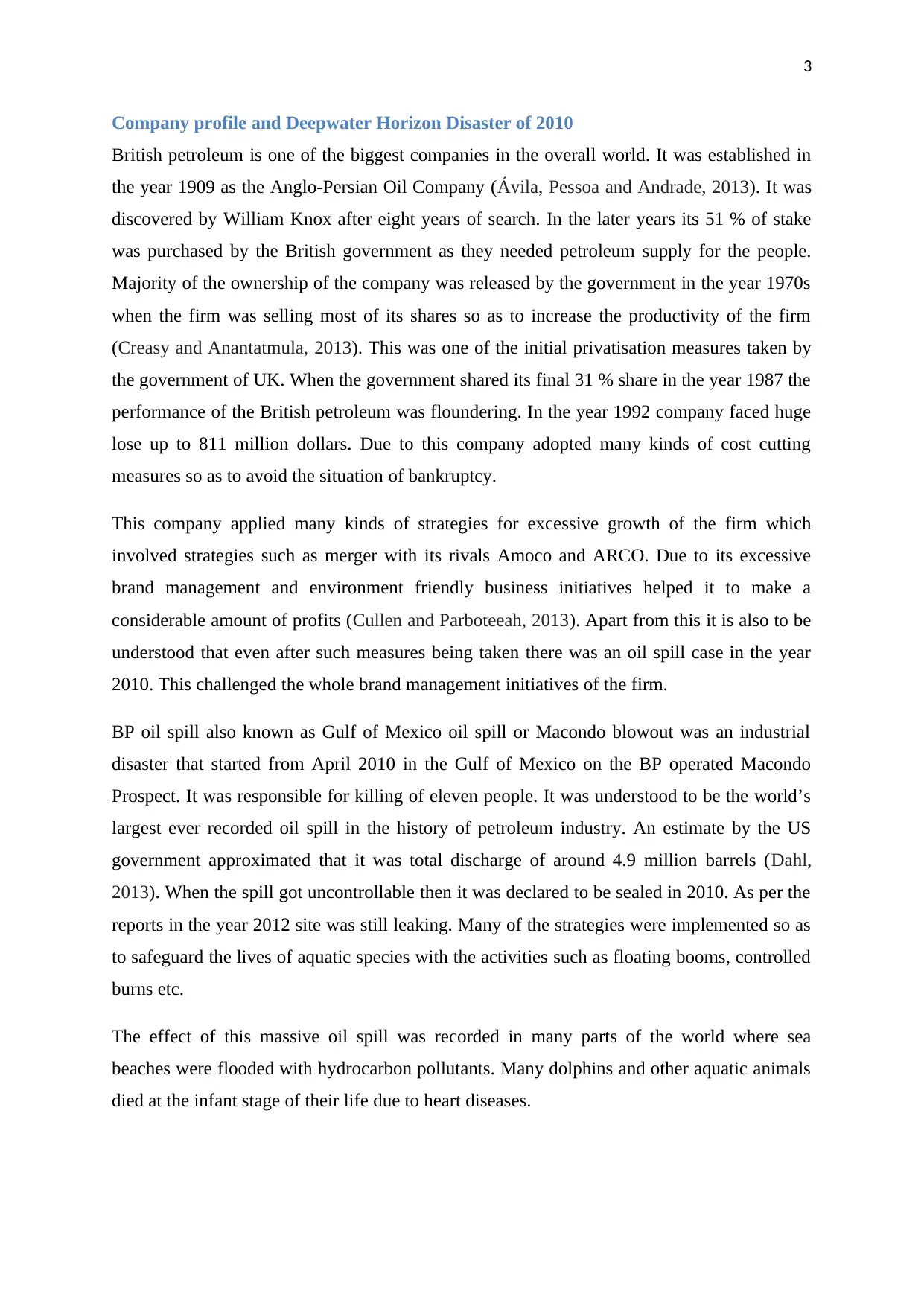
3
Company profile and Deepwater Horizon Disaster of 2010
British petroleum is one of the biggest companies in the overall world. It was established in
the year 1909 as the Anglo-Persian Oil Company (Ávila, Pessoa and Andrade, 2013). It was
discovered by William Knox after eight years of search. In the later years its 51 % of stake
was purchased by the British government as they needed petroleum supply for the people.
Majority of the ownership of the company was released by the government in the year 1970s
when the firm was selling most of its shares so as to increase the productivity of the firm
(Creasy and Anantatmula, 2013). This was one of the initial privatisation measures taken by
the government of UK. When the government shared its final 31 % share in the year 1987 the
performance of the British petroleum was floundering. In the year 1992 company faced huge
lose up to 811 million dollars. Due to this company adopted many kinds of cost cutting
measures so as to avoid the situation of bankruptcy.
This company applied many kinds of strategies for excessive growth of the firm which
involved strategies such as merger with its rivals Amoco and ARCO. Due to its excessive
brand management and environment friendly business initiatives helped it to make a
considerable amount of profits (Cullen and Parboteeah, 2013). Apart from this it is also to be
understood that even after such measures being taken there was an oil spill case in the year
2010. This challenged the whole brand management initiatives of the firm.
BP oil spill also known as Gulf of Mexico oil spill or Macondo blowout was an industrial
disaster that started from April 2010 in the Gulf of Mexico on the BP operated Macondo
Prospect. It was responsible for killing of eleven people. It was understood to be the world’s
largest ever recorded oil spill in the history of petroleum industry. An estimate by the US
government approximated that it was total discharge of around 4.9 million barrels (Dahl,
2013). When the spill got uncontrollable then it was declared to be sealed in 2010. As per the
reports in the year 2012 site was still leaking. Many of the strategies were implemented so as
to safeguard the lives of aquatic species with the activities such as floating booms, controlled
burns etc.
The effect of this massive oil spill was recorded in many parts of the world where sea
beaches were flooded with hydrocarbon pollutants. Many dolphins and other aquatic animals
died at the infant stage of their life due to heart diseases.
Company profile and Deepwater Horizon Disaster of 2010
British petroleum is one of the biggest companies in the overall world. It was established in
the year 1909 as the Anglo-Persian Oil Company (Ávila, Pessoa and Andrade, 2013). It was
discovered by William Knox after eight years of search. In the later years its 51 % of stake
was purchased by the British government as they needed petroleum supply for the people.
Majority of the ownership of the company was released by the government in the year 1970s
when the firm was selling most of its shares so as to increase the productivity of the firm
(Creasy and Anantatmula, 2013). This was one of the initial privatisation measures taken by
the government of UK. When the government shared its final 31 % share in the year 1987 the
performance of the British petroleum was floundering. In the year 1992 company faced huge
lose up to 811 million dollars. Due to this company adopted many kinds of cost cutting
measures so as to avoid the situation of bankruptcy.
This company applied many kinds of strategies for excessive growth of the firm which
involved strategies such as merger with its rivals Amoco and ARCO. Due to its excessive
brand management and environment friendly business initiatives helped it to make a
considerable amount of profits (Cullen and Parboteeah, 2013). Apart from this it is also to be
understood that even after such measures being taken there was an oil spill case in the year
2010. This challenged the whole brand management initiatives of the firm.
BP oil spill also known as Gulf of Mexico oil spill or Macondo blowout was an industrial
disaster that started from April 2010 in the Gulf of Mexico on the BP operated Macondo
Prospect. It was responsible for killing of eleven people. It was understood to be the world’s
largest ever recorded oil spill in the history of petroleum industry. An estimate by the US
government approximated that it was total discharge of around 4.9 million barrels (Dahl,
2013). When the spill got uncontrollable then it was declared to be sealed in 2010. As per the
reports in the year 2012 site was still leaking. Many of the strategies were implemented so as
to safeguard the lives of aquatic species with the activities such as floating booms, controlled
burns etc.
The effect of this massive oil spill was recorded in many parts of the world where sea
beaches were flooded with hydrocarbon pollutants. Many dolphins and other aquatic animals
died at the infant stage of their life due to heart diseases.
Secure Best Marks with AI Grader
Need help grading? Try our AI Grader for instant feedback on your assignments.
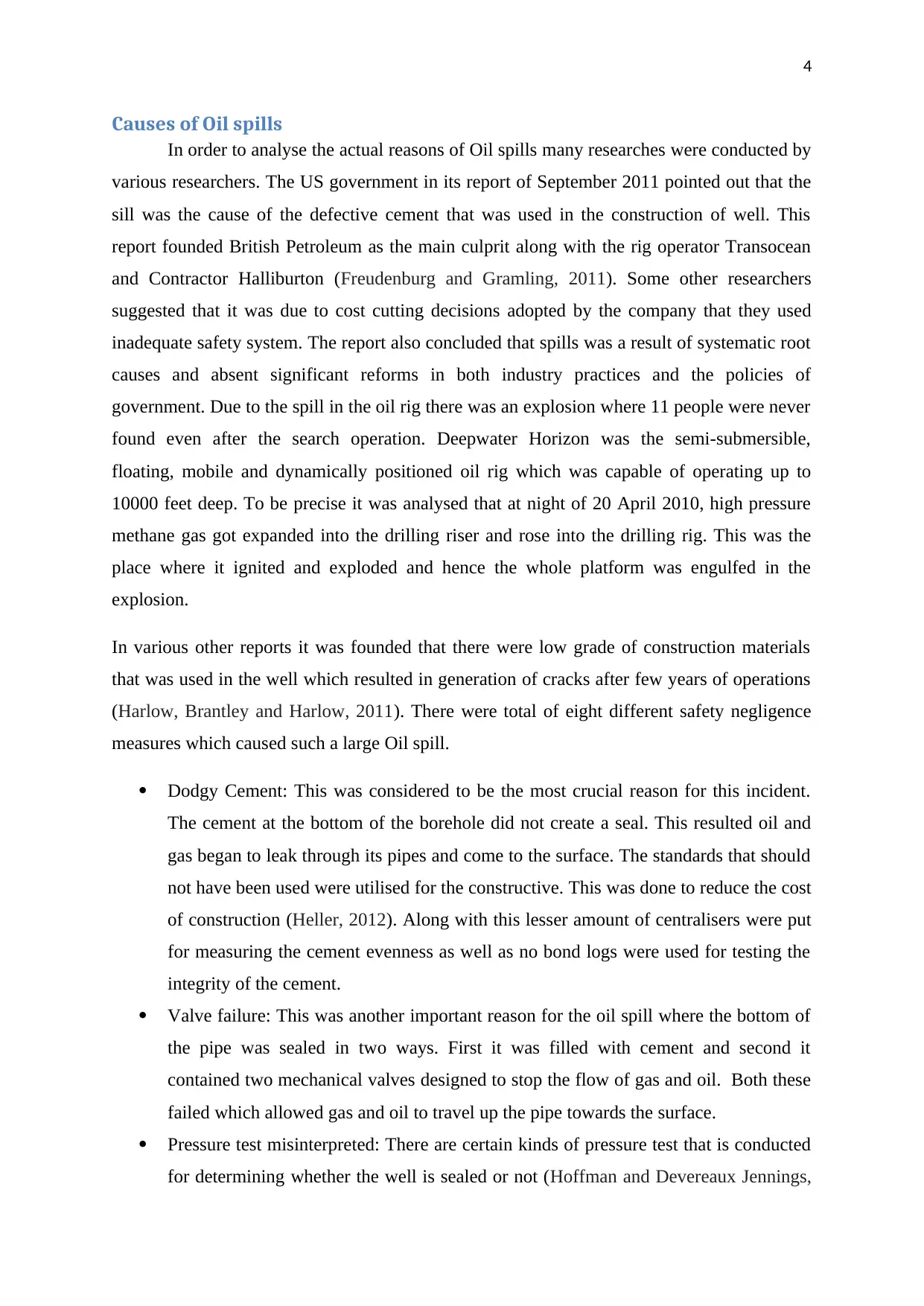
4
Causes of Oil spills
In order to analyse the actual reasons of Oil spills many researches were conducted by
various researchers. The US government in its report of September 2011 pointed out that the
sill was the cause of the defective cement that was used in the construction of well. This
report founded British Petroleum as the main culprit along with the rig operator Transocean
and Contractor Halliburton (Freudenburg and Gramling, 2011). Some other researchers
suggested that it was due to cost cutting decisions adopted by the company that they used
inadequate safety system. The report also concluded that spills was a result of systematic root
causes and absent significant reforms in both industry practices and the policies of
government. Due to the spill in the oil rig there was an explosion where 11 people were never
found even after the search operation. Deepwater Horizon was the semi-submersible,
floating, mobile and dynamically positioned oil rig which was capable of operating up to
10000 feet deep. To be precise it was analysed that at night of 20 April 2010, high pressure
methane gas got expanded into the drilling riser and rose into the drilling rig. This was the
place where it ignited and exploded and hence the whole platform was engulfed in the
explosion.
In various other reports it was founded that there were low grade of construction materials
that was used in the well which resulted in generation of cracks after few years of operations
(Harlow, Brantley and Harlow, 2011). There were total of eight different safety negligence
measures which caused such a large Oil spill.
Dodgy Cement: This was considered to be the most crucial reason for this incident.
The cement at the bottom of the borehole did not create a seal. This resulted oil and
gas began to leak through its pipes and come to the surface. The standards that should
not have been used were utilised for the constructive. This was done to reduce the cost
of construction (Heller, 2012). Along with this lesser amount of centralisers were put
for measuring the cement evenness as well as no bond logs were used for testing the
integrity of the cement.
Valve failure: This was another important reason for the oil spill where the bottom of
the pipe was sealed in two ways. First it was filled with cement and second it
contained two mechanical valves designed to stop the flow of gas and oil. Both these
failed which allowed gas and oil to travel up the pipe towards the surface.
Pressure test misinterpreted: There are certain kinds of pressure test that is conducted
for determining whether the well is sealed or not (Hoffman and Devereaux Jennings,
Causes of Oil spills
In order to analyse the actual reasons of Oil spills many researches were conducted by
various researchers. The US government in its report of September 2011 pointed out that the
sill was the cause of the defective cement that was used in the construction of well. This
report founded British Petroleum as the main culprit along with the rig operator Transocean
and Contractor Halliburton (Freudenburg and Gramling, 2011). Some other researchers
suggested that it was due to cost cutting decisions adopted by the company that they used
inadequate safety system. The report also concluded that spills was a result of systematic root
causes and absent significant reforms in both industry practices and the policies of
government. Due to the spill in the oil rig there was an explosion where 11 people were never
found even after the search operation. Deepwater Horizon was the semi-submersible,
floating, mobile and dynamically positioned oil rig which was capable of operating up to
10000 feet deep. To be precise it was analysed that at night of 20 April 2010, high pressure
methane gas got expanded into the drilling riser and rose into the drilling rig. This was the
place where it ignited and exploded and hence the whole platform was engulfed in the
explosion.
In various other reports it was founded that there were low grade of construction materials
that was used in the well which resulted in generation of cracks after few years of operations
(Harlow, Brantley and Harlow, 2011). There were total of eight different safety negligence
measures which caused such a large Oil spill.
Dodgy Cement: This was considered to be the most crucial reason for this incident.
The cement at the bottom of the borehole did not create a seal. This resulted oil and
gas began to leak through its pipes and come to the surface. The standards that should
not have been used were utilised for the constructive. This was done to reduce the cost
of construction (Heller, 2012). Along with this lesser amount of centralisers were put
for measuring the cement evenness as well as no bond logs were used for testing the
integrity of the cement.
Valve failure: This was another important reason for the oil spill where the bottom of
the pipe was sealed in two ways. First it was filled with cement and second it
contained two mechanical valves designed to stop the flow of gas and oil. Both these
failed which allowed gas and oil to travel up the pipe towards the surface.
Pressure test misinterpreted: There are certain kinds of pressure test that is conducted
for determining whether the well is sealed or not (Hoffman and Devereaux Jennings,
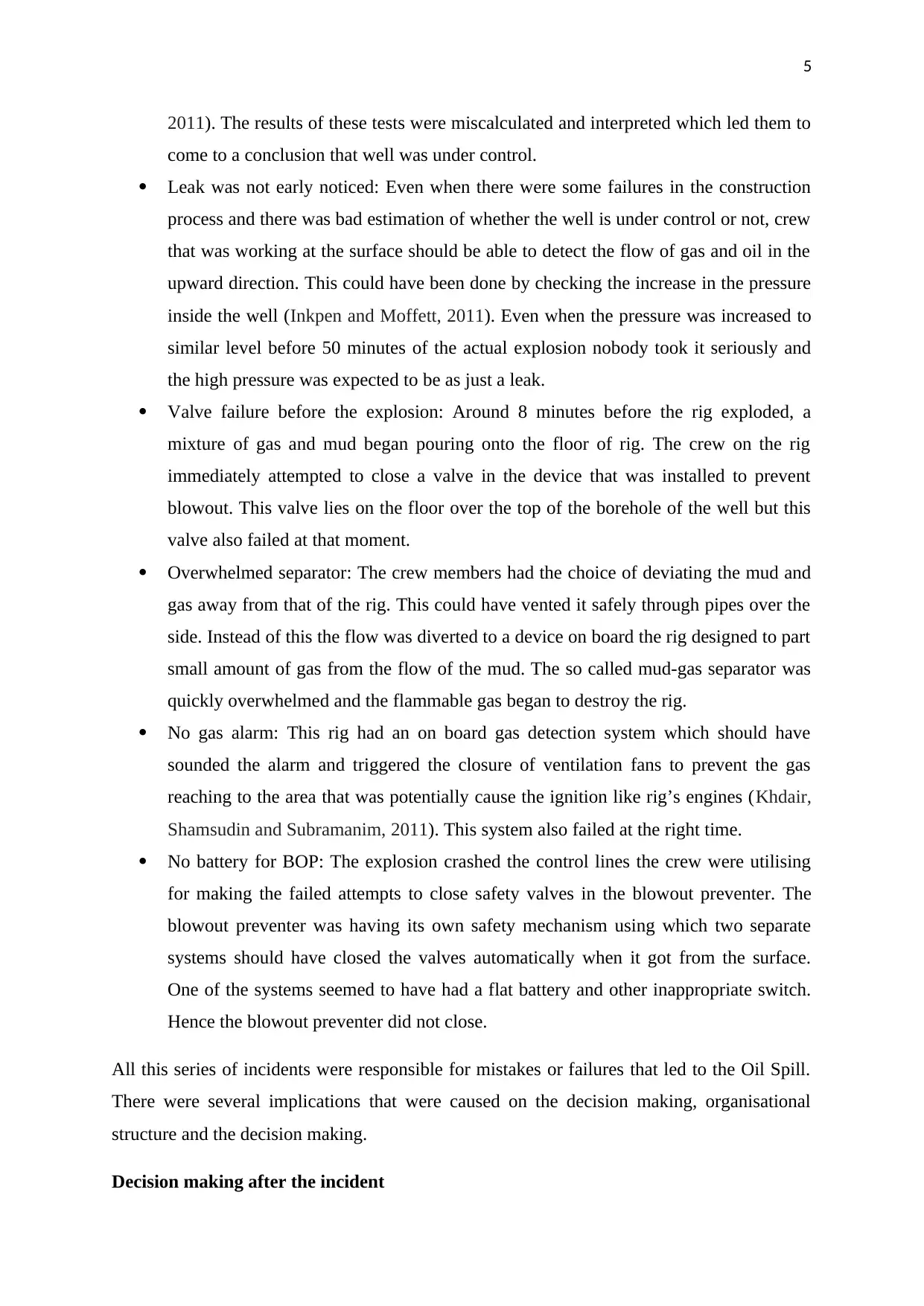
5
2011). The results of these tests were miscalculated and interpreted which led them to
come to a conclusion that well was under control.
Leak was not early noticed: Even when there were some failures in the construction
process and there was bad estimation of whether the well is under control or not, crew
that was working at the surface should be able to detect the flow of gas and oil in the
upward direction. This could have been done by checking the increase in the pressure
inside the well (Inkpen and Moffett, 2011). Even when the pressure was increased to
similar level before 50 minutes of the actual explosion nobody took it seriously and
the high pressure was expected to be as just a leak.
Valve failure before the explosion: Around 8 minutes before the rig exploded, a
mixture of gas and mud began pouring onto the floor of rig. The crew on the rig
immediately attempted to close a valve in the device that was installed to prevent
blowout. This valve lies on the floor over the top of the borehole of the well but this
valve also failed at that moment.
Overwhelmed separator: The crew members had the choice of deviating the mud and
gas away from that of the rig. This could have vented it safely through pipes over the
side. Instead of this the flow was diverted to a device on board the rig designed to part
small amount of gas from the flow of the mud. The so called mud-gas separator was
quickly overwhelmed and the flammable gas began to destroy the rig.
No gas alarm: This rig had an on board gas detection system which should have
sounded the alarm and triggered the closure of ventilation fans to prevent the gas
reaching to the area that was potentially cause the ignition like rig’s engines (Khdair,
Shamsudin and Subramanim, 2011). This system also failed at the right time.
No battery for BOP: The explosion crashed the control lines the crew were utilising
for making the failed attempts to close safety valves in the blowout preventer. The
blowout preventer was having its own safety mechanism using which two separate
systems should have closed the valves automatically when it got from the surface.
One of the systems seemed to have had a flat battery and other inappropriate switch.
Hence the blowout preventer did not close.
All this series of incidents were responsible for mistakes or failures that led to the Oil Spill.
There were several implications that were caused on the decision making, organisational
structure and the decision making.
Decision making after the incident
2011). The results of these tests were miscalculated and interpreted which led them to
come to a conclusion that well was under control.
Leak was not early noticed: Even when there were some failures in the construction
process and there was bad estimation of whether the well is under control or not, crew
that was working at the surface should be able to detect the flow of gas and oil in the
upward direction. This could have been done by checking the increase in the pressure
inside the well (Inkpen and Moffett, 2011). Even when the pressure was increased to
similar level before 50 minutes of the actual explosion nobody took it seriously and
the high pressure was expected to be as just a leak.
Valve failure before the explosion: Around 8 minutes before the rig exploded, a
mixture of gas and mud began pouring onto the floor of rig. The crew on the rig
immediately attempted to close a valve in the device that was installed to prevent
blowout. This valve lies on the floor over the top of the borehole of the well but this
valve also failed at that moment.
Overwhelmed separator: The crew members had the choice of deviating the mud and
gas away from that of the rig. This could have vented it safely through pipes over the
side. Instead of this the flow was diverted to a device on board the rig designed to part
small amount of gas from the flow of the mud. The so called mud-gas separator was
quickly overwhelmed and the flammable gas began to destroy the rig.
No gas alarm: This rig had an on board gas detection system which should have
sounded the alarm and triggered the closure of ventilation fans to prevent the gas
reaching to the area that was potentially cause the ignition like rig’s engines (Khdair,
Shamsudin and Subramanim, 2011). This system also failed at the right time.
No battery for BOP: The explosion crashed the control lines the crew were utilising
for making the failed attempts to close safety valves in the blowout preventer. The
blowout preventer was having its own safety mechanism using which two separate
systems should have closed the valves automatically when it got from the surface.
One of the systems seemed to have had a flat battery and other inappropriate switch.
Hence the blowout preventer did not close.
All this series of incidents were responsible for mistakes or failures that led to the Oil Spill.
There were several implications that were caused on the decision making, organisational
structure and the decision making.
Decision making after the incident
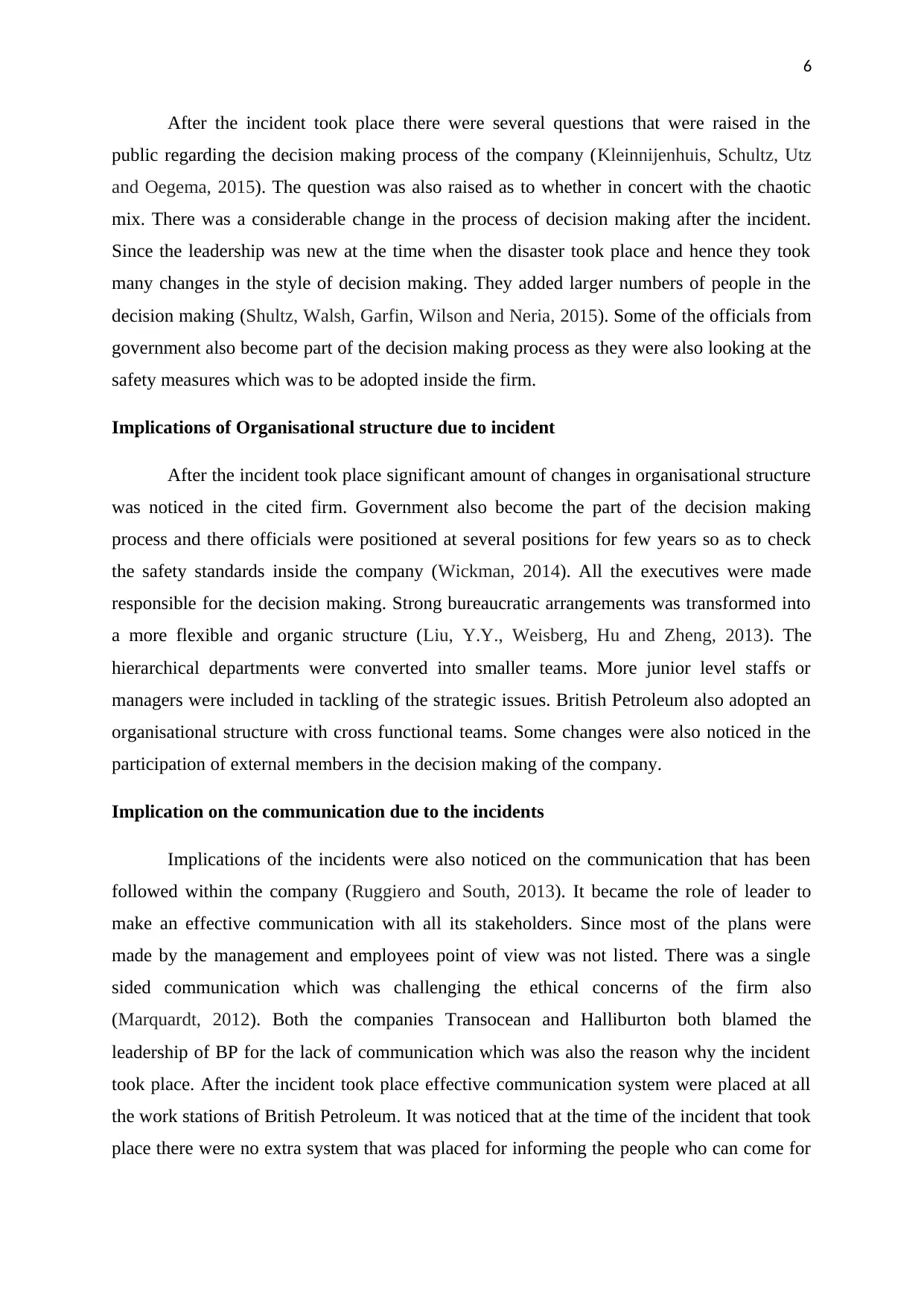
6
After the incident took place there were several questions that were raised in the
public regarding the decision making process of the company (Kleinnijenhuis, Schultz, Utz
and Oegema, 2015). The question was also raised as to whether in concert with the chaotic
mix. There was a considerable change in the process of decision making after the incident.
Since the leadership was new at the time when the disaster took place and hence they took
many changes in the style of decision making. They added larger numbers of people in the
decision making (Shultz, Walsh, Garfin, Wilson and Neria, 2015). Some of the officials from
government also become part of the decision making process as they were also looking at the
safety measures which was to be adopted inside the firm.
Implications of Organisational structure due to incident
After the incident took place significant amount of changes in organisational structure
was noticed in the cited firm. Government also become the part of the decision making
process and there officials were positioned at several positions for few years so as to check
the safety standards inside the company (Wickman, 2014). All the executives were made
responsible for the decision making. Strong bureaucratic arrangements was transformed into
a more flexible and organic structure (Liu, Y.Y., Weisberg, Hu and Zheng, 2013). The
hierarchical departments were converted into smaller teams. More junior level staffs or
managers were included in tackling of the strategic issues. British Petroleum also adopted an
organisational structure with cross functional teams. Some changes were also noticed in the
participation of external members in the decision making of the company.
Implication on the communication due to the incidents
Implications of the incidents were also noticed on the communication that has been
followed within the company (Ruggiero and South, 2013). It became the role of leader to
make an effective communication with all its stakeholders. Since most of the plans were
made by the management and employees point of view was not listed. There was a single
sided communication which was challenging the ethical concerns of the firm also
(Marquardt, 2012). Both the companies Transocean and Halliburton both blamed the
leadership of BP for the lack of communication which was also the reason why the incident
took place. After the incident took place effective communication system were placed at all
the work stations of British Petroleum. It was noticed that at the time of the incident that took
place there were no extra system that was placed for informing the people who can come for
After the incident took place there were several questions that were raised in the
public regarding the decision making process of the company (Kleinnijenhuis, Schultz, Utz
and Oegema, 2015). The question was also raised as to whether in concert with the chaotic
mix. There was a considerable change in the process of decision making after the incident.
Since the leadership was new at the time when the disaster took place and hence they took
many changes in the style of decision making. They added larger numbers of people in the
decision making (Shultz, Walsh, Garfin, Wilson and Neria, 2015). Some of the officials from
government also become part of the decision making process as they were also looking at the
safety measures which was to be adopted inside the firm.
Implications of Organisational structure due to incident
After the incident took place significant amount of changes in organisational structure
was noticed in the cited firm. Government also become the part of the decision making
process and there officials were positioned at several positions for few years so as to check
the safety standards inside the company (Wickman, 2014). All the executives were made
responsible for the decision making. Strong bureaucratic arrangements was transformed into
a more flexible and organic structure (Liu, Y.Y., Weisberg, Hu and Zheng, 2013). The
hierarchical departments were converted into smaller teams. More junior level staffs or
managers were included in tackling of the strategic issues. British Petroleum also adopted an
organisational structure with cross functional teams. Some changes were also noticed in the
participation of external members in the decision making of the company.
Implication on the communication due to the incidents
Implications of the incidents were also noticed on the communication that has been
followed within the company (Ruggiero and South, 2013). It became the role of leader to
make an effective communication with all its stakeholders. Since most of the plans were
made by the management and employees point of view was not listed. There was a single
sided communication which was challenging the ethical concerns of the firm also
(Marquardt, 2012). Both the companies Transocean and Halliburton both blamed the
leadership of BP for the lack of communication which was also the reason why the incident
took place. After the incident took place effective communication system were placed at all
the work stations of British Petroleum. It was noticed that at the time of the incident that took
place there were no extra system that was placed for informing the people who can come for
Paraphrase This Document
Need a fresh take? Get an instant paraphrase of this document with our AI Paraphraser
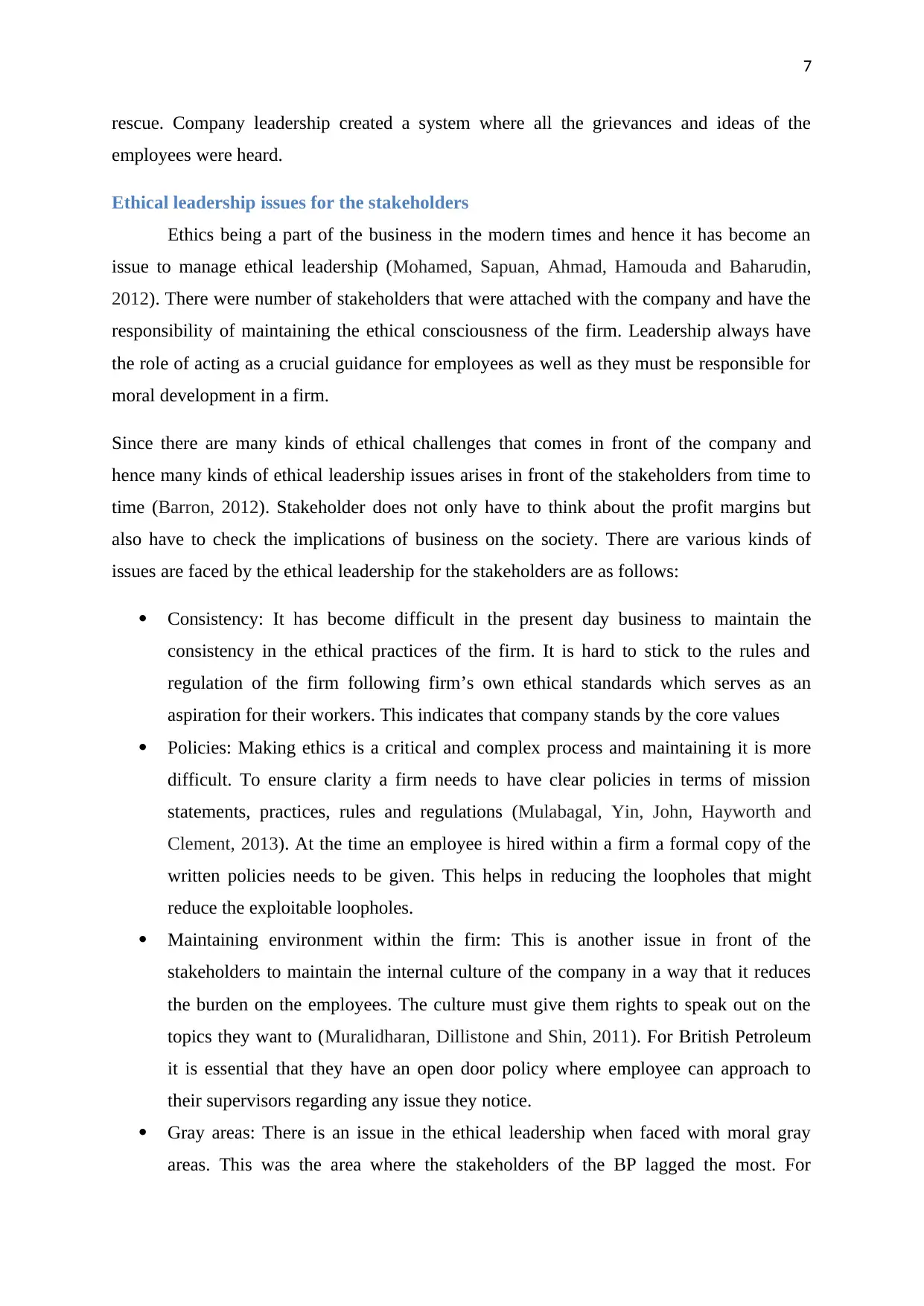
7
rescue. Company leadership created a system where all the grievances and ideas of the
employees were heard.
Ethical leadership issues for the stakeholders
Ethics being a part of the business in the modern times and hence it has become an
issue to manage ethical leadership (Mohamed, Sapuan, Ahmad, Hamouda and Baharudin,
2012). There were number of stakeholders that were attached with the company and have the
responsibility of maintaining the ethical consciousness of the firm. Leadership always have
the role of acting as a crucial guidance for employees as well as they must be responsible for
moral development in a firm.
Since there are many kinds of ethical challenges that comes in front of the company and
hence many kinds of ethical leadership issues arises in front of the stakeholders from time to
time (Barron, 2012). Stakeholder does not only have to think about the profit margins but
also have to check the implications of business on the society. There are various kinds of
issues are faced by the ethical leadership for the stakeholders are as follows:
Consistency: It has become difficult in the present day business to maintain the
consistency in the ethical practices of the firm. It is hard to stick to the rules and
regulation of the firm following firm’s own ethical standards which serves as an
aspiration for their workers. This indicates that company stands by the core values
Policies: Making ethics is a critical and complex process and maintaining it is more
difficult. To ensure clarity a firm needs to have clear policies in terms of mission
statements, practices, rules and regulations (Mulabagal, Yin, John, Hayworth and
Clement, 2013). At the time an employee is hired within a firm a formal copy of the
written policies needs to be given. This helps in reducing the loopholes that might
reduce the exploitable loopholes.
Maintaining environment within the firm: This is another issue in front of the
stakeholders to maintain the internal culture of the company in a way that it reduces
the burden on the employees. The culture must give them rights to speak out on the
topics they want to (Muralidharan, Dillistone and Shin, 2011). For British Petroleum
it is essential that they have an open door policy where employee can approach to
their supervisors regarding any issue they notice.
Gray areas: There is an issue in the ethical leadership when faced with moral gray
areas. This was the area where the stakeholders of the BP lagged the most. For
rescue. Company leadership created a system where all the grievances and ideas of the
employees were heard.
Ethical leadership issues for the stakeholders
Ethics being a part of the business in the modern times and hence it has become an
issue to manage ethical leadership (Mohamed, Sapuan, Ahmad, Hamouda and Baharudin,
2012). There were number of stakeholders that were attached with the company and have the
responsibility of maintaining the ethical consciousness of the firm. Leadership always have
the role of acting as a crucial guidance for employees as well as they must be responsible for
moral development in a firm.
Since there are many kinds of ethical challenges that comes in front of the company and
hence many kinds of ethical leadership issues arises in front of the stakeholders from time to
time (Barron, 2012). Stakeholder does not only have to think about the profit margins but
also have to check the implications of business on the society. There are various kinds of
issues are faced by the ethical leadership for the stakeholders are as follows:
Consistency: It has become difficult in the present day business to maintain the
consistency in the ethical practices of the firm. It is hard to stick to the rules and
regulation of the firm following firm’s own ethical standards which serves as an
aspiration for their workers. This indicates that company stands by the core values
Policies: Making ethics is a critical and complex process and maintaining it is more
difficult. To ensure clarity a firm needs to have clear policies in terms of mission
statements, practices, rules and regulations (Mulabagal, Yin, John, Hayworth and
Clement, 2013). At the time an employee is hired within a firm a formal copy of the
written policies needs to be given. This helps in reducing the loopholes that might
reduce the exploitable loopholes.
Maintaining environment within the firm: This is another issue in front of the
stakeholders to maintain the internal culture of the company in a way that it reduces
the burden on the employees. The culture must give them rights to speak out on the
topics they want to (Muralidharan, Dillistone and Shin, 2011). For British Petroleum
it is essential that they have an open door policy where employee can approach to
their supervisors regarding any issue they notice.
Gray areas: There is an issue in the ethical leadership when faced with moral gray
areas. This was the area where the stakeholders of the BP lagged the most. For
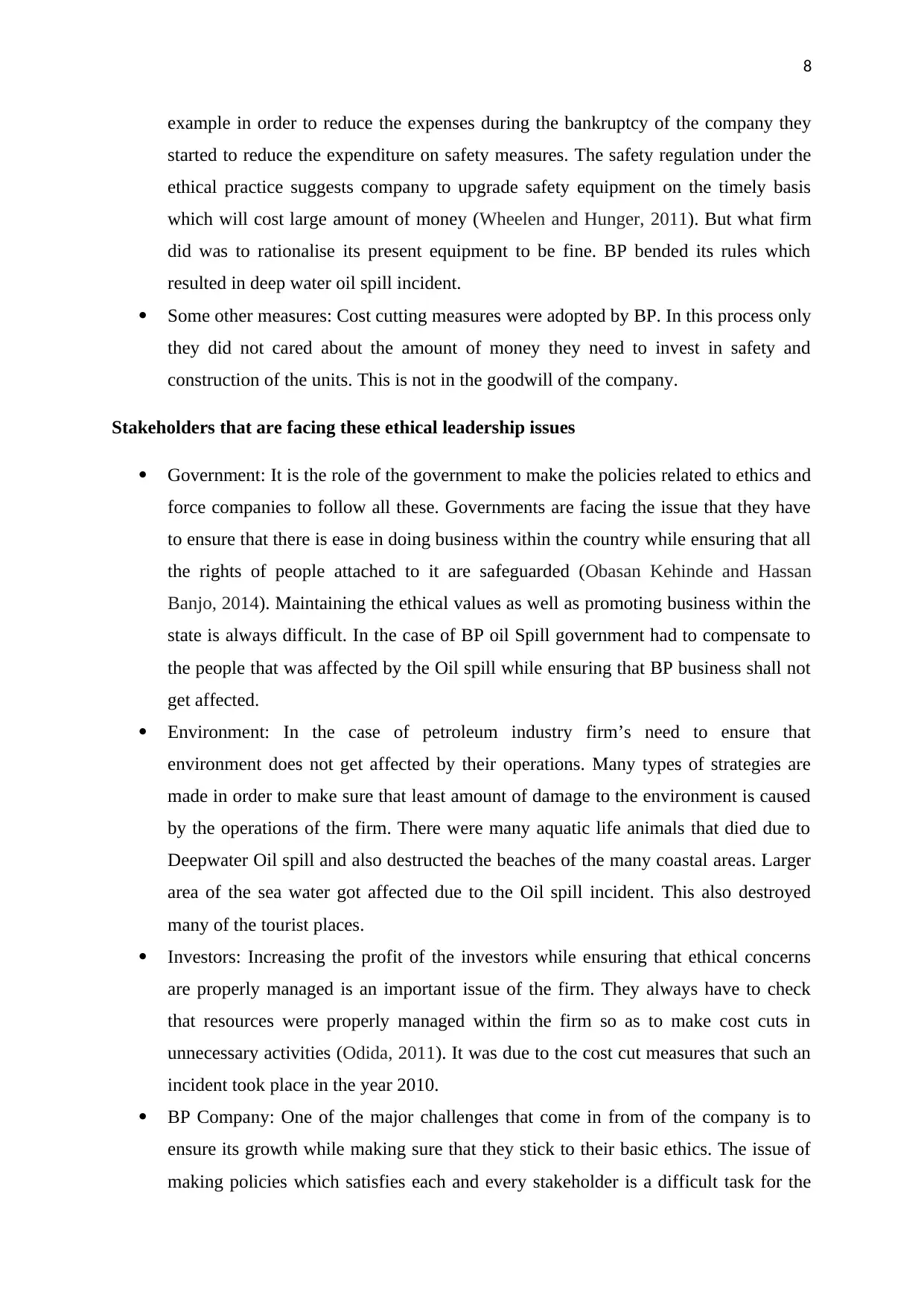
8
example in order to reduce the expenses during the bankruptcy of the company they
started to reduce the expenditure on safety measures. The safety regulation under the
ethical practice suggests company to upgrade safety equipment on the timely basis
which will cost large amount of money (Wheelen and Hunger, 2011). But what firm
did was to rationalise its present equipment to be fine. BP bended its rules which
resulted in deep water oil spill incident.
Some other measures: Cost cutting measures were adopted by BP. In this process only
they did not cared about the amount of money they need to invest in safety and
construction of the units. This is not in the goodwill of the company.
Stakeholders that are facing these ethical leadership issues
Government: It is the role of the government to make the policies related to ethics and
force companies to follow all these. Governments are facing the issue that they have
to ensure that there is ease in doing business within the country while ensuring that all
the rights of people attached to it are safeguarded (Obasan Kehinde and Hassan
Banjo, 2014). Maintaining the ethical values as well as promoting business within the
state is always difficult. In the case of BP oil Spill government had to compensate to
the people that was affected by the Oil spill while ensuring that BP business shall not
get affected.
Environment: In the case of petroleum industry firm’s need to ensure that
environment does not get affected by their operations. Many types of strategies are
made in order to make sure that least amount of damage to the environment is caused
by the operations of the firm. There were many aquatic life animals that died due to
Deepwater Oil spill and also destructed the beaches of the many coastal areas. Larger
area of the sea water got affected due to the Oil spill incident. This also destroyed
many of the tourist places.
Investors: Increasing the profit of the investors while ensuring that ethical concerns
are properly managed is an important issue of the firm. They always have to check
that resources were properly managed within the firm so as to make cost cuts in
unnecessary activities (Odida, 2011). It was due to the cost cut measures that such an
incident took place in the year 2010.
BP Company: One of the major challenges that come in from of the company is to
ensure its growth while making sure that they stick to their basic ethics. The issue of
making policies which satisfies each and every stakeholder is a difficult task for the
example in order to reduce the expenses during the bankruptcy of the company they
started to reduce the expenditure on safety measures. The safety regulation under the
ethical practice suggests company to upgrade safety equipment on the timely basis
which will cost large amount of money (Wheelen and Hunger, 2011). But what firm
did was to rationalise its present equipment to be fine. BP bended its rules which
resulted in deep water oil spill incident.
Some other measures: Cost cutting measures were adopted by BP. In this process only
they did not cared about the amount of money they need to invest in safety and
construction of the units. This is not in the goodwill of the company.
Stakeholders that are facing these ethical leadership issues
Government: It is the role of the government to make the policies related to ethics and
force companies to follow all these. Governments are facing the issue that they have
to ensure that there is ease in doing business within the country while ensuring that all
the rights of people attached to it are safeguarded (Obasan Kehinde and Hassan
Banjo, 2014). Maintaining the ethical values as well as promoting business within the
state is always difficult. In the case of BP oil Spill government had to compensate to
the people that was affected by the Oil spill while ensuring that BP business shall not
get affected.
Environment: In the case of petroleum industry firm’s need to ensure that
environment does not get affected by their operations. Many types of strategies are
made in order to make sure that least amount of damage to the environment is caused
by the operations of the firm. There were many aquatic life animals that died due to
Deepwater Oil spill and also destructed the beaches of the many coastal areas. Larger
area of the sea water got affected due to the Oil spill incident. This also destroyed
many of the tourist places.
Investors: Increasing the profit of the investors while ensuring that ethical concerns
are properly managed is an important issue of the firm. They always have to check
that resources were properly managed within the firm so as to make cost cuts in
unnecessary activities (Odida, 2011). It was due to the cost cut measures that such an
incident took place in the year 2010.
BP Company: One of the major challenges that come in from of the company is to
ensure its growth while making sure that they stick to their basic ethics. The issue of
making policies which satisfies each and every stakeholder is a difficult task for the
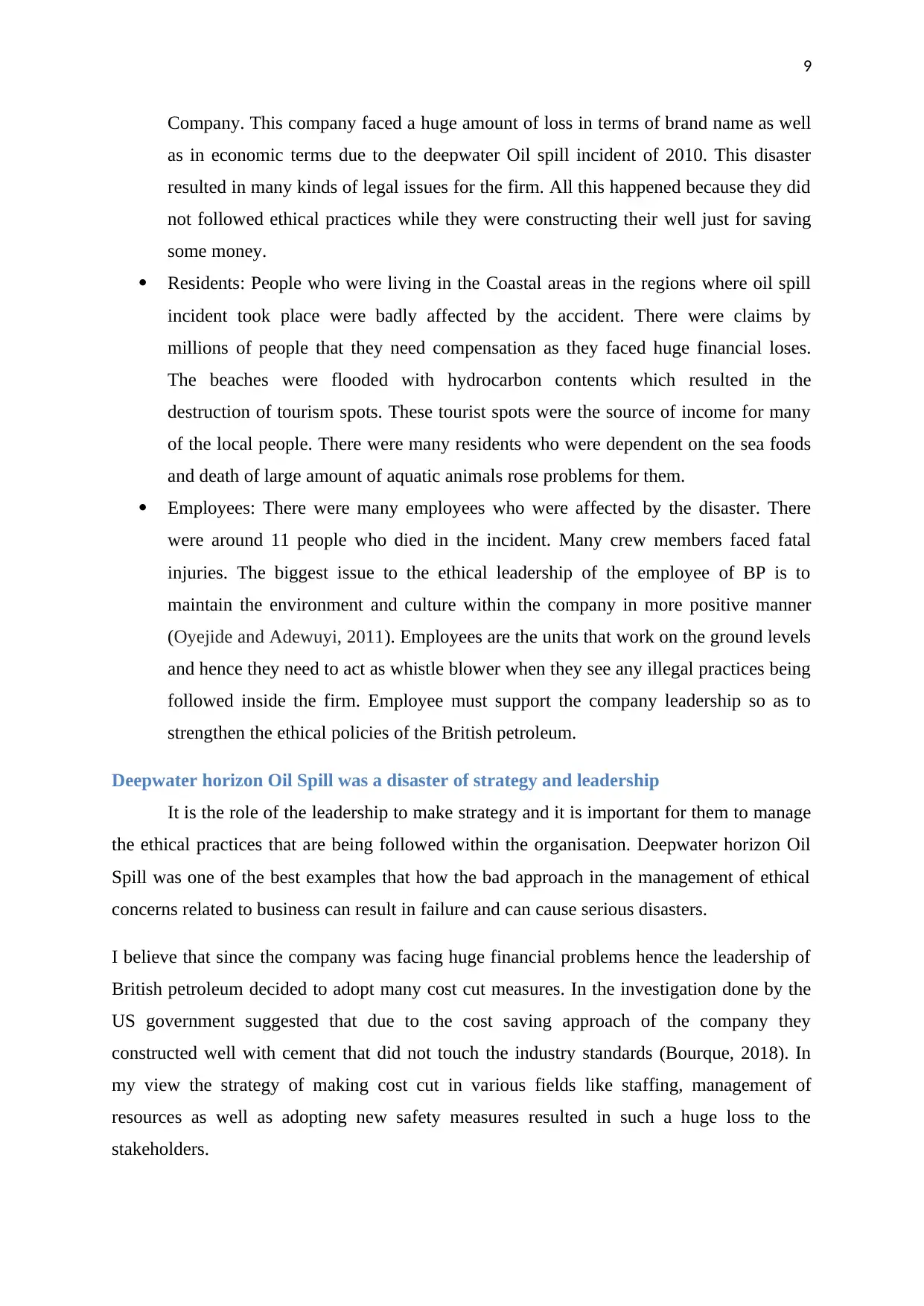
9
Company. This company faced a huge amount of loss in terms of brand name as well
as in economic terms due to the deepwater Oil spill incident of 2010. This disaster
resulted in many kinds of legal issues for the firm. All this happened because they did
not followed ethical practices while they were constructing their well just for saving
some money.
Residents: People who were living in the Coastal areas in the regions where oil spill
incident took place were badly affected by the accident. There were claims by
millions of people that they need compensation as they faced huge financial loses.
The beaches were flooded with hydrocarbon contents which resulted in the
destruction of tourism spots. These tourist spots were the source of income for many
of the local people. There were many residents who were dependent on the sea foods
and death of large amount of aquatic animals rose problems for them.
Employees: There were many employees who were affected by the disaster. There
were around 11 people who died in the incident. Many crew members faced fatal
injuries. The biggest issue to the ethical leadership of the employee of BP is to
maintain the environment and culture within the company in more positive manner
(Oyejide and Adewuyi, 2011). Employees are the units that work on the ground levels
and hence they need to act as whistle blower when they see any illegal practices being
followed inside the firm. Employee must support the company leadership so as to
strengthen the ethical policies of the British petroleum.
Deepwater horizon Oil Spill was a disaster of strategy and leadership
It is the role of the leadership to make strategy and it is important for them to manage
the ethical practices that are being followed within the organisation. Deepwater horizon Oil
Spill was one of the best examples that how the bad approach in the management of ethical
concerns related to business can result in failure and can cause serious disasters.
I believe that since the company was facing huge financial problems hence the leadership of
British petroleum decided to adopt many cost cut measures. In the investigation done by the
US government suggested that due to the cost saving approach of the company they
constructed well with cement that did not touch the industry standards (Bourque, 2018). In
my view the strategy of making cost cut in various fields like staffing, management of
resources as well as adopting new safety measures resulted in such a huge loss to the
stakeholders.
Company. This company faced a huge amount of loss in terms of brand name as well
as in economic terms due to the deepwater Oil spill incident of 2010. This disaster
resulted in many kinds of legal issues for the firm. All this happened because they did
not followed ethical practices while they were constructing their well just for saving
some money.
Residents: People who were living in the Coastal areas in the regions where oil spill
incident took place were badly affected by the accident. There were claims by
millions of people that they need compensation as they faced huge financial loses.
The beaches were flooded with hydrocarbon contents which resulted in the
destruction of tourism spots. These tourist spots were the source of income for many
of the local people. There were many residents who were dependent on the sea foods
and death of large amount of aquatic animals rose problems for them.
Employees: There were many employees who were affected by the disaster. There
were around 11 people who died in the incident. Many crew members faced fatal
injuries. The biggest issue to the ethical leadership of the employee of BP is to
maintain the environment and culture within the company in more positive manner
(Oyejide and Adewuyi, 2011). Employees are the units that work on the ground levels
and hence they need to act as whistle blower when they see any illegal practices being
followed inside the firm. Employee must support the company leadership so as to
strengthen the ethical policies of the British petroleum.
Deepwater horizon Oil Spill was a disaster of strategy and leadership
It is the role of the leadership to make strategy and it is important for them to manage
the ethical practices that are being followed within the organisation. Deepwater horizon Oil
Spill was one of the best examples that how the bad approach in the management of ethical
concerns related to business can result in failure and can cause serious disasters.
I believe that since the company was facing huge financial problems hence the leadership of
British petroleum decided to adopt many cost cut measures. In the investigation done by the
US government suggested that due to the cost saving approach of the company they
constructed well with cement that did not touch the industry standards (Bourque, 2018). In
my view the strategy of making cost cut in various fields like staffing, management of
resources as well as adopting new safety measures resulted in such a huge loss to the
stakeholders.
Secure Best Marks with AI Grader
Need help grading? Try our AI Grader for instant feedback on your assignments.
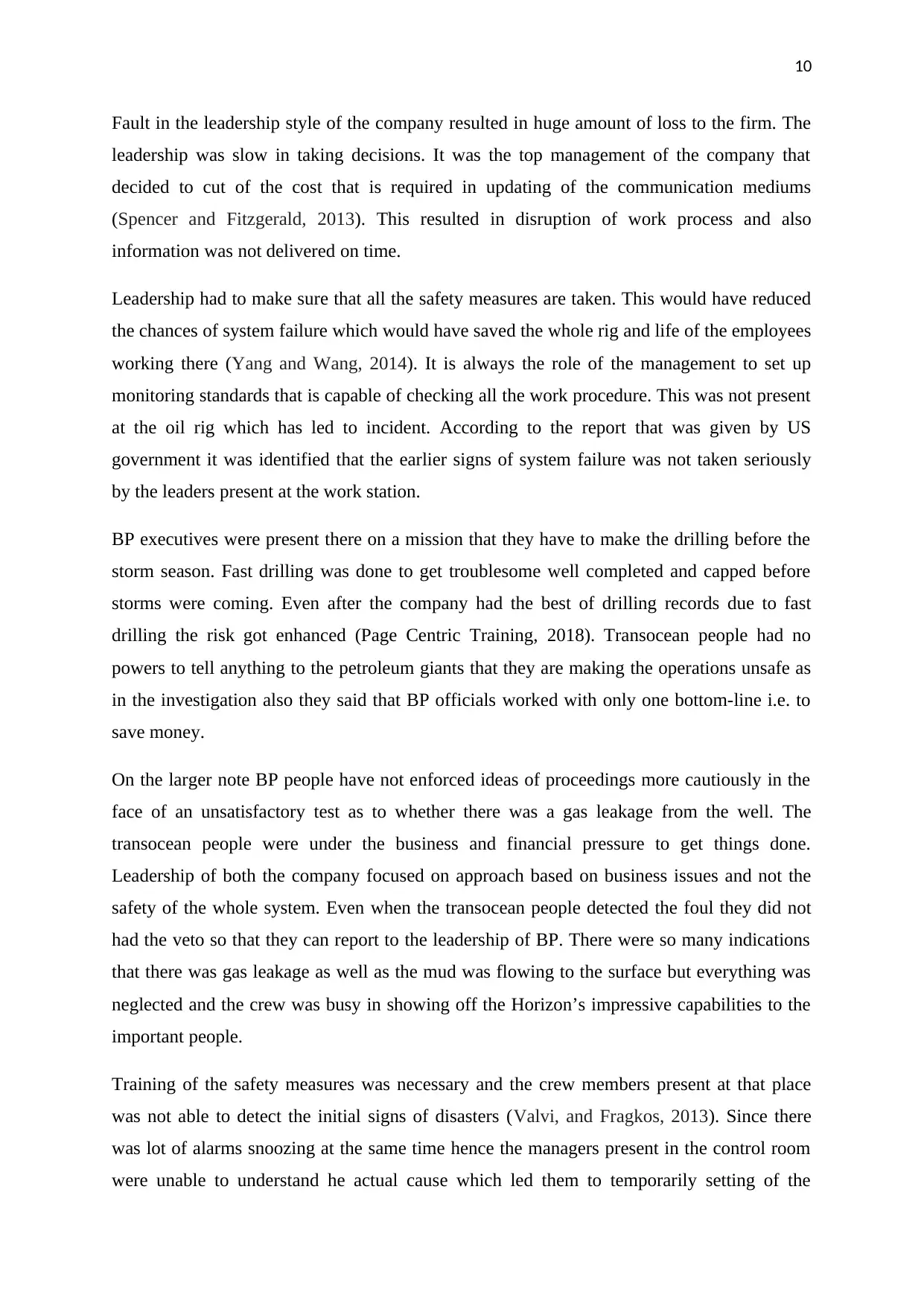
10
Fault in the leadership style of the company resulted in huge amount of loss to the firm. The
leadership was slow in taking decisions. It was the top management of the company that
decided to cut of the cost that is required in updating of the communication mediums
(Spencer and Fitzgerald, 2013). This resulted in disruption of work process and also
information was not delivered on time.
Leadership had to make sure that all the safety measures are taken. This would have reduced
the chances of system failure which would have saved the whole rig and life of the employees
working there (Yang and Wang, 2014). It is always the role of the management to set up
monitoring standards that is capable of checking all the work procedure. This was not present
at the oil rig which has led to incident. According to the report that was given by US
government it was identified that the earlier signs of system failure was not taken seriously
by the leaders present at the work station.
BP executives were present there on a mission that they have to make the drilling before the
storm season. Fast drilling was done to get troublesome well completed and capped before
storms were coming. Even after the company had the best of drilling records due to fast
drilling the risk got enhanced (Page Centric Training, 2018). Transocean people had no
powers to tell anything to the petroleum giants that they are making the operations unsafe as
in the investigation also they said that BP officials worked with only one bottom-line i.e. to
save money.
On the larger note BP people have not enforced ideas of proceedings more cautiously in the
face of an unsatisfactory test as to whether there was a gas leakage from the well. The
transocean people were under the business and financial pressure to get things done.
Leadership of both the company focused on approach based on business issues and not the
safety of the whole system. Even when the transocean people detected the foul they did not
had the veto so that they can report to the leadership of BP. There were so many indications
that there was gas leakage as well as the mud was flowing to the surface but everything was
neglected and the crew was busy in showing off the Horizon’s impressive capabilities to the
important people.
Training of the safety measures was necessary and the crew members present at that place
was not able to detect the initial signs of disasters (Valvi, and Fragkos, 2013). Since there
was lot of alarms snoozing at the same time hence the managers present in the control room
were unable to understand he actual cause which led them to temporarily setting of the
Fault in the leadership style of the company resulted in huge amount of loss to the firm. The
leadership was slow in taking decisions. It was the top management of the company that
decided to cut of the cost that is required in updating of the communication mediums
(Spencer and Fitzgerald, 2013). This resulted in disruption of work process and also
information was not delivered on time.
Leadership had to make sure that all the safety measures are taken. This would have reduced
the chances of system failure which would have saved the whole rig and life of the employees
working there (Yang and Wang, 2014). It is always the role of the management to set up
monitoring standards that is capable of checking all the work procedure. This was not present
at the oil rig which has led to incident. According to the report that was given by US
government it was identified that the earlier signs of system failure was not taken seriously
by the leaders present at the work station.
BP executives were present there on a mission that they have to make the drilling before the
storm season. Fast drilling was done to get troublesome well completed and capped before
storms were coming. Even after the company had the best of drilling records due to fast
drilling the risk got enhanced (Page Centric Training, 2018). Transocean people had no
powers to tell anything to the petroleum giants that they are making the operations unsafe as
in the investigation also they said that BP officials worked with only one bottom-line i.e. to
save money.
On the larger note BP people have not enforced ideas of proceedings more cautiously in the
face of an unsatisfactory test as to whether there was a gas leakage from the well. The
transocean people were under the business and financial pressure to get things done.
Leadership of both the company focused on approach based on business issues and not the
safety of the whole system. Even when the transocean people detected the foul they did not
had the veto so that they can report to the leadership of BP. There were so many indications
that there was gas leakage as well as the mud was flowing to the surface but everything was
neglected and the crew was busy in showing off the Horizon’s impressive capabilities to the
important people.
Training of the safety measures was necessary and the crew members present at that place
was not able to detect the initial signs of disasters (Valvi, and Fragkos, 2013). Since there
was lot of alarms snoozing at the same time hence the managers present in the control room
were unable to understand he actual cause which led them to temporarily setting of the
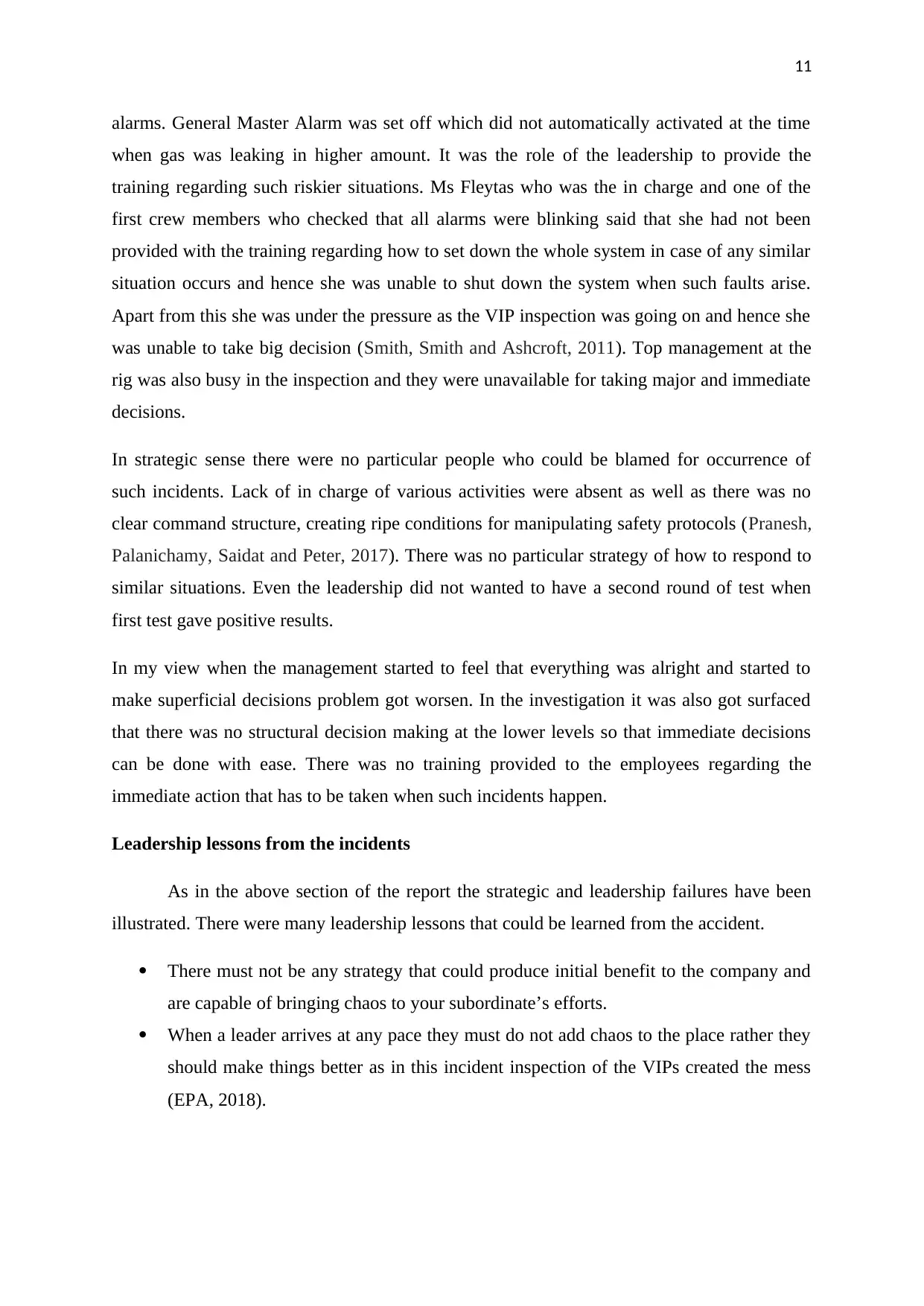
11
alarms. General Master Alarm was set off which did not automatically activated at the time
when gas was leaking in higher amount. It was the role of the leadership to provide the
training regarding such riskier situations. Ms Fleytas who was the in charge and one of the
first crew members who checked that all alarms were blinking said that she had not been
provided with the training regarding how to set down the whole system in case of any similar
situation occurs and hence she was unable to shut down the system when such faults arise.
Apart from this she was under the pressure as the VIP inspection was going on and hence she
was unable to take big decision (Smith, Smith and Ashcroft, 2011). Top management at the
rig was also busy in the inspection and they were unavailable for taking major and immediate
decisions.
In strategic sense there were no particular people who could be blamed for occurrence of
such incidents. Lack of in charge of various activities were absent as well as there was no
clear command structure, creating ripe conditions for manipulating safety protocols (Pranesh,
Palanichamy, Saidat and Peter, 2017). There was no particular strategy of how to respond to
similar situations. Even the leadership did not wanted to have a second round of test when
first test gave positive results.
In my view when the management started to feel that everything was alright and started to
make superficial decisions problem got worsen. In the investigation it was also got surfaced
that there was no structural decision making at the lower levels so that immediate decisions
can be done with ease. There was no training provided to the employees regarding the
immediate action that has to be taken when such incidents happen.
Leadership lessons from the incidents
As in the above section of the report the strategic and leadership failures have been
illustrated. There were many leadership lessons that could be learned from the accident.
There must not be any strategy that could produce initial benefit to the company and
are capable of bringing chaos to your subordinate’s efforts.
When a leader arrives at any pace they must do not add chaos to the place rather they
should make things better as in this incident inspection of the VIPs created the mess
(EPA, 2018).
alarms. General Master Alarm was set off which did not automatically activated at the time
when gas was leaking in higher amount. It was the role of the leadership to provide the
training regarding such riskier situations. Ms Fleytas who was the in charge and one of the
first crew members who checked that all alarms were blinking said that she had not been
provided with the training regarding how to set down the whole system in case of any similar
situation occurs and hence she was unable to shut down the system when such faults arise.
Apart from this she was under the pressure as the VIP inspection was going on and hence she
was unable to take big decision (Smith, Smith and Ashcroft, 2011). Top management at the
rig was also busy in the inspection and they were unavailable for taking major and immediate
decisions.
In strategic sense there were no particular people who could be blamed for occurrence of
such incidents. Lack of in charge of various activities were absent as well as there was no
clear command structure, creating ripe conditions for manipulating safety protocols (Pranesh,
Palanichamy, Saidat and Peter, 2017). There was no particular strategy of how to respond to
similar situations. Even the leadership did not wanted to have a second round of test when
first test gave positive results.
In my view when the management started to feel that everything was alright and started to
make superficial decisions problem got worsen. In the investigation it was also got surfaced
that there was no structural decision making at the lower levels so that immediate decisions
can be done with ease. There was no training provided to the employees regarding the
immediate action that has to be taken when such incidents happen.
Leadership lessons from the incidents
As in the above section of the report the strategic and leadership failures have been
illustrated. There were many leadership lessons that could be learned from the accident.
There must not be any strategy that could produce initial benefit to the company and
are capable of bringing chaos to your subordinate’s efforts.
When a leader arrives at any pace they must do not add chaos to the place rather they
should make things better as in this incident inspection of the VIPs created the mess
(EPA, 2018).
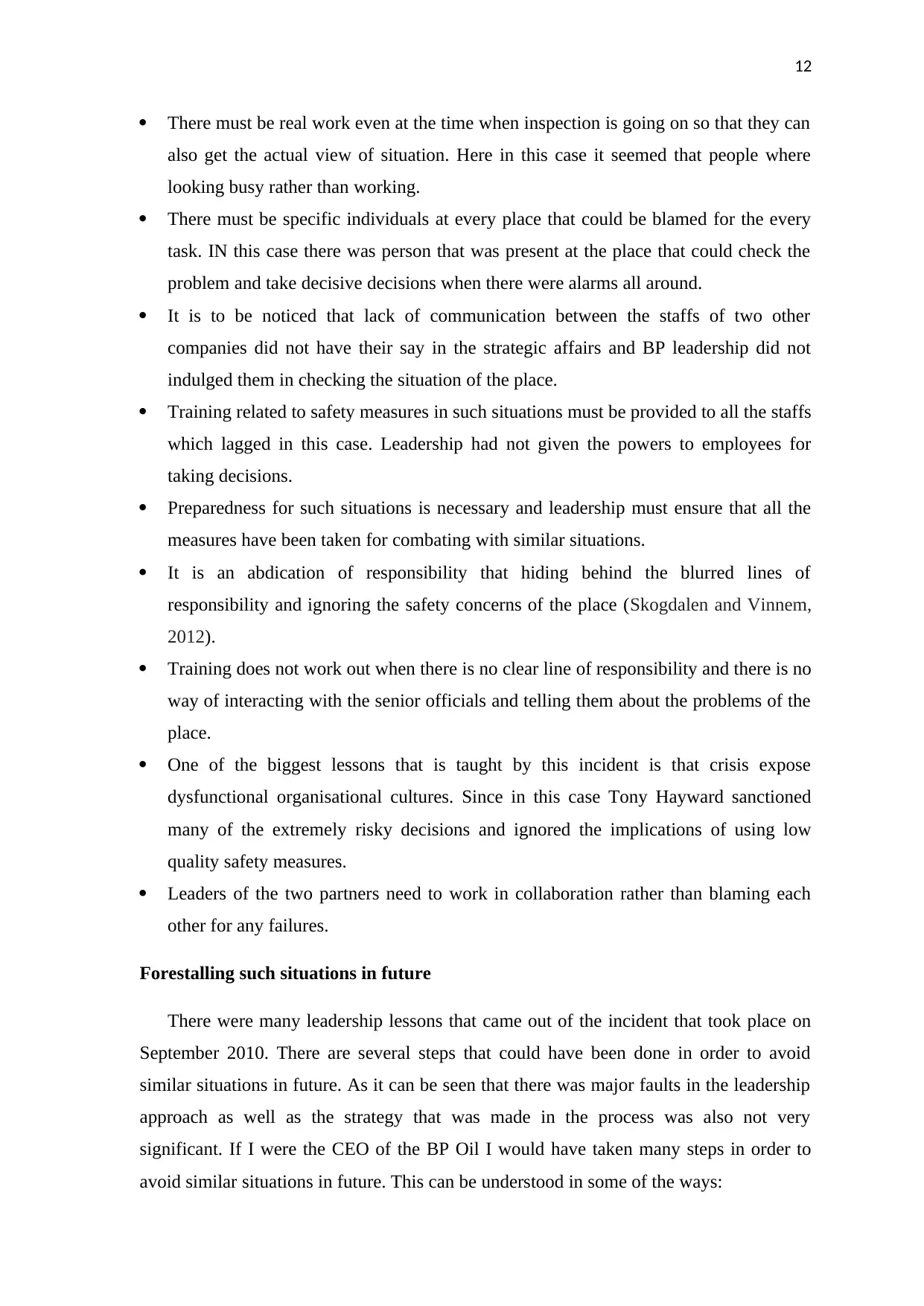
12
There must be real work even at the time when inspection is going on so that they can
also get the actual view of situation. Here in this case it seemed that people where
looking busy rather than working.
There must be specific individuals at every place that could be blamed for the every
task. IN this case there was person that was present at the place that could check the
problem and take decisive decisions when there were alarms all around.
It is to be noticed that lack of communication between the staffs of two other
companies did not have their say in the strategic affairs and BP leadership did not
indulged them in checking the situation of the place.
Training related to safety measures in such situations must be provided to all the staffs
which lagged in this case. Leadership had not given the powers to employees for
taking decisions.
Preparedness for such situations is necessary and leadership must ensure that all the
measures have been taken for combating with similar situations.
It is an abdication of responsibility that hiding behind the blurred lines of
responsibility and ignoring the safety concerns of the place (Skogdalen and Vinnem,
2012).
Training does not work out when there is no clear line of responsibility and there is no
way of interacting with the senior officials and telling them about the problems of the
place.
One of the biggest lessons that is taught by this incident is that crisis expose
dysfunctional organisational cultures. Since in this case Tony Hayward sanctioned
many of the extremely risky decisions and ignored the implications of using low
quality safety measures.
Leaders of the two partners need to work in collaboration rather than blaming each
other for any failures.
Forestalling such situations in future
There were many leadership lessons that came out of the incident that took place on
September 2010. There are several steps that could have been done in order to avoid
similar situations in future. As it can be seen that there was major faults in the leadership
approach as well as the strategy that was made in the process was also not very
significant. If I were the CEO of the BP Oil I would have taken many steps in order to
avoid similar situations in future. This can be understood in some of the ways:
There must be real work even at the time when inspection is going on so that they can
also get the actual view of situation. Here in this case it seemed that people where
looking busy rather than working.
There must be specific individuals at every place that could be blamed for the every
task. IN this case there was person that was present at the place that could check the
problem and take decisive decisions when there were alarms all around.
It is to be noticed that lack of communication between the staffs of two other
companies did not have their say in the strategic affairs and BP leadership did not
indulged them in checking the situation of the place.
Training related to safety measures in such situations must be provided to all the staffs
which lagged in this case. Leadership had not given the powers to employees for
taking decisions.
Preparedness for such situations is necessary and leadership must ensure that all the
measures have been taken for combating with similar situations.
It is an abdication of responsibility that hiding behind the blurred lines of
responsibility and ignoring the safety concerns of the place (Skogdalen and Vinnem,
2012).
Training does not work out when there is no clear line of responsibility and there is no
way of interacting with the senior officials and telling them about the problems of the
place.
One of the biggest lessons that is taught by this incident is that crisis expose
dysfunctional organisational cultures. Since in this case Tony Hayward sanctioned
many of the extremely risky decisions and ignored the implications of using low
quality safety measures.
Leaders of the two partners need to work in collaboration rather than blaming each
other for any failures.
Forestalling such situations in future
There were many leadership lessons that came out of the incident that took place on
September 2010. There are several steps that could have been done in order to avoid
similar situations in future. As it can be seen that there was major faults in the leadership
approach as well as the strategy that was made in the process was also not very
significant. If I were the CEO of the BP Oil I would have taken many steps in order to
avoid similar situations in future. This can be understood in some of the ways:
Paraphrase This Document
Need a fresh take? Get an instant paraphrase of this document with our AI Paraphraser
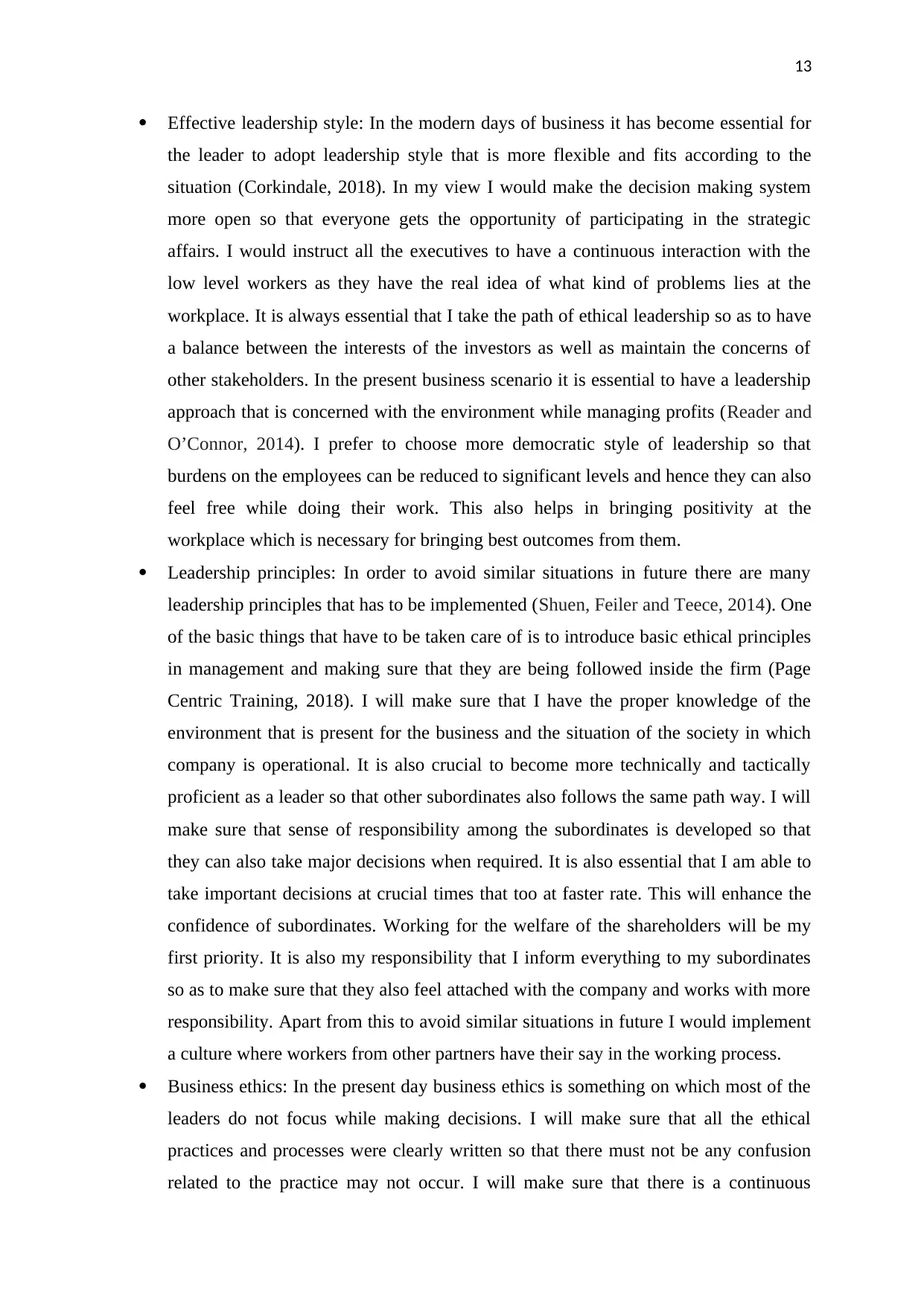
13
Effective leadership style: In the modern days of business it has become essential for
the leader to adopt leadership style that is more flexible and fits according to the
situation (Corkindale, 2018). In my view I would make the decision making system
more open so that everyone gets the opportunity of participating in the strategic
affairs. I would instruct all the executives to have a continuous interaction with the
low level workers as they have the real idea of what kind of problems lies at the
workplace. It is always essential that I take the path of ethical leadership so as to have
a balance between the interests of the investors as well as maintain the concerns of
other stakeholders. In the present business scenario it is essential to have a leadership
approach that is concerned with the environment while managing profits (Reader and
O’Connor, 2014). I prefer to choose more democratic style of leadership so that
burdens on the employees can be reduced to significant levels and hence they can also
feel free while doing their work. This also helps in bringing positivity at the
workplace which is necessary for bringing best outcomes from them.
Leadership principles: In order to avoid similar situations in future there are many
leadership principles that has to be implemented (Shuen, Feiler and Teece, 2014). One
of the basic things that have to be taken care of is to introduce basic ethical principles
in management and making sure that they are being followed inside the firm (Page
Centric Training, 2018). I will make sure that I have the proper knowledge of the
environment that is present for the business and the situation of the society in which
company is operational. It is also crucial to become more technically and tactically
proficient as a leader so that other subordinates also follows the same path way. I will
make sure that sense of responsibility among the subordinates is developed so that
they can also take major decisions when required. It is also essential that I am able to
take important decisions at crucial times that too at faster rate. This will enhance the
confidence of subordinates. Working for the welfare of the shareholders will be my
first priority. It is also my responsibility that I inform everything to my subordinates
so as to make sure that they also feel attached with the company and works with more
responsibility. Apart from this to avoid similar situations in future I would implement
a culture where workers from other partners have their say in the working process.
Business ethics: In the present day business ethics is something on which most of the
leaders do not focus while making decisions. I will make sure that all the ethical
practices and processes were clearly written so that there must not be any confusion
related to the practice may not occur. I will make sure that there is a continuous
Effective leadership style: In the modern days of business it has become essential for
the leader to adopt leadership style that is more flexible and fits according to the
situation (Corkindale, 2018). In my view I would make the decision making system
more open so that everyone gets the opportunity of participating in the strategic
affairs. I would instruct all the executives to have a continuous interaction with the
low level workers as they have the real idea of what kind of problems lies at the
workplace. It is always essential that I take the path of ethical leadership so as to have
a balance between the interests of the investors as well as maintain the concerns of
other stakeholders. In the present business scenario it is essential to have a leadership
approach that is concerned with the environment while managing profits (Reader and
O’Connor, 2014). I prefer to choose more democratic style of leadership so that
burdens on the employees can be reduced to significant levels and hence they can also
feel free while doing their work. This also helps in bringing positivity at the
workplace which is necessary for bringing best outcomes from them.
Leadership principles: In order to avoid similar situations in future there are many
leadership principles that has to be implemented (Shuen, Feiler and Teece, 2014). One
of the basic things that have to be taken care of is to introduce basic ethical principles
in management and making sure that they are being followed inside the firm (Page
Centric Training, 2018). I will make sure that I have the proper knowledge of the
environment that is present for the business and the situation of the society in which
company is operational. It is also crucial to become more technically and tactically
proficient as a leader so that other subordinates also follows the same path way. I will
make sure that sense of responsibility among the subordinates is developed so that
they can also take major decisions when required. It is also essential that I am able to
take important decisions at crucial times that too at faster rate. This will enhance the
confidence of subordinates. Working for the welfare of the shareholders will be my
first priority. It is also my responsibility that I inform everything to my subordinates
so as to make sure that they also feel attached with the company and works with more
responsibility. Apart from this to avoid similar situations in future I would implement
a culture where workers from other partners have their say in the working process.
Business ethics: In the present day business ethics is something on which most of the
leaders do not focus while making decisions. I will make sure that all the ethical
practices and processes were clearly written so that there must not be any confusion
related to the practice may not occur. I will make sure that there is a continuous
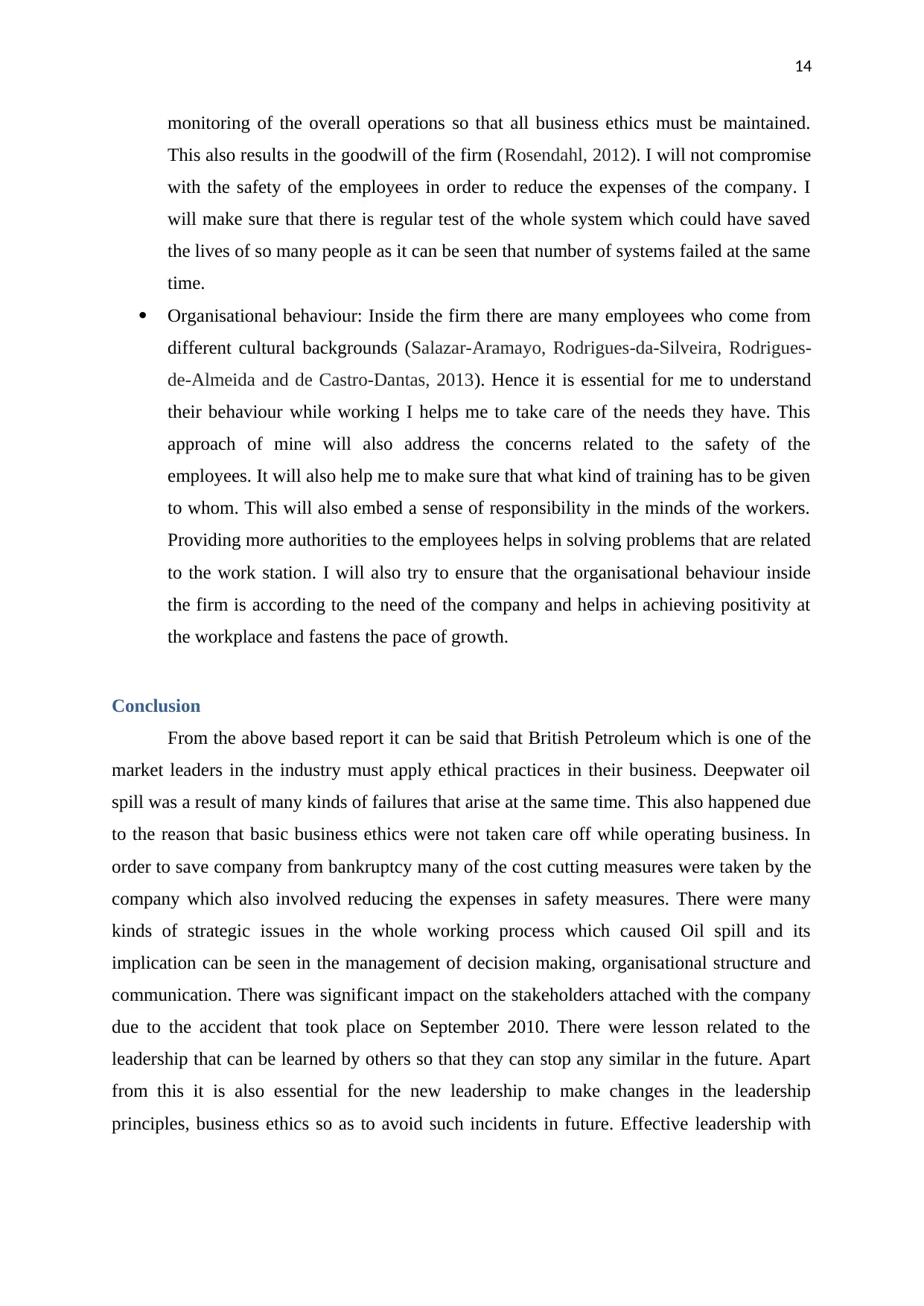
14
monitoring of the overall operations so that all business ethics must be maintained.
This also results in the goodwill of the firm (Rosendahl, 2012). I will not compromise
with the safety of the employees in order to reduce the expenses of the company. I
will make sure that there is regular test of the whole system which could have saved
the lives of so many people as it can be seen that number of systems failed at the same
time.
Organisational behaviour: Inside the firm there are many employees who come from
different cultural backgrounds (Salazar-Aramayo, Rodrigues-da-Silveira, Rodrigues-
de-Almeida and de Castro-Dantas, 2013). Hence it is essential for me to understand
their behaviour while working I helps me to take care of the needs they have. This
approach of mine will also address the concerns related to the safety of the
employees. It will also help me to make sure that what kind of training has to be given
to whom. This will also embed a sense of responsibility in the minds of the workers.
Providing more authorities to the employees helps in solving problems that are related
to the work station. I will also try to ensure that the organisational behaviour inside
the firm is according to the need of the company and helps in achieving positivity at
the workplace and fastens the pace of growth.
Conclusion
From the above based report it can be said that British Petroleum which is one of the
market leaders in the industry must apply ethical practices in their business. Deepwater oil
spill was a result of many kinds of failures that arise at the same time. This also happened due
to the reason that basic business ethics were not taken care off while operating business. In
order to save company from bankruptcy many of the cost cutting measures were taken by the
company which also involved reducing the expenses in safety measures. There were many
kinds of strategic issues in the whole working process which caused Oil spill and its
implication can be seen in the management of decision making, organisational structure and
communication. There was significant impact on the stakeholders attached with the company
due to the accident that took place on September 2010. There were lesson related to the
leadership that can be learned by others so that they can stop any similar in the future. Apart
from this it is also essential for the new leadership to make changes in the leadership
principles, business ethics so as to avoid such incidents in future. Effective leadership with
monitoring of the overall operations so that all business ethics must be maintained.
This also results in the goodwill of the firm (Rosendahl, 2012). I will not compromise
with the safety of the employees in order to reduce the expenses of the company. I
will make sure that there is regular test of the whole system which could have saved
the lives of so many people as it can be seen that number of systems failed at the same
time.
Organisational behaviour: Inside the firm there are many employees who come from
different cultural backgrounds (Salazar-Aramayo, Rodrigues-da-Silveira, Rodrigues-
de-Almeida and de Castro-Dantas, 2013). Hence it is essential for me to understand
their behaviour while working I helps me to take care of the needs they have. This
approach of mine will also address the concerns related to the safety of the
employees. It will also help me to make sure that what kind of training has to be given
to whom. This will also embed a sense of responsibility in the minds of the workers.
Providing more authorities to the employees helps in solving problems that are related
to the work station. I will also try to ensure that the organisational behaviour inside
the firm is according to the need of the company and helps in achieving positivity at
the workplace and fastens the pace of growth.
Conclusion
From the above based report it can be said that British Petroleum which is one of the
market leaders in the industry must apply ethical practices in their business. Deepwater oil
spill was a result of many kinds of failures that arise at the same time. This also happened due
to the reason that basic business ethics were not taken care off while operating business. In
order to save company from bankruptcy many of the cost cutting measures were taken by the
company which also involved reducing the expenses in safety measures. There were many
kinds of strategic issues in the whole working process which caused Oil spill and its
implication can be seen in the management of decision making, organisational structure and
communication. There was significant impact on the stakeholders attached with the company
due to the accident that took place on September 2010. There were lesson related to the
leadership that can be learned by others so that they can stop any similar in the future. Apart
from this it is also essential for the new leadership to make changes in the leadership
principles, business ethics so as to avoid such incidents in future. Effective leadership with
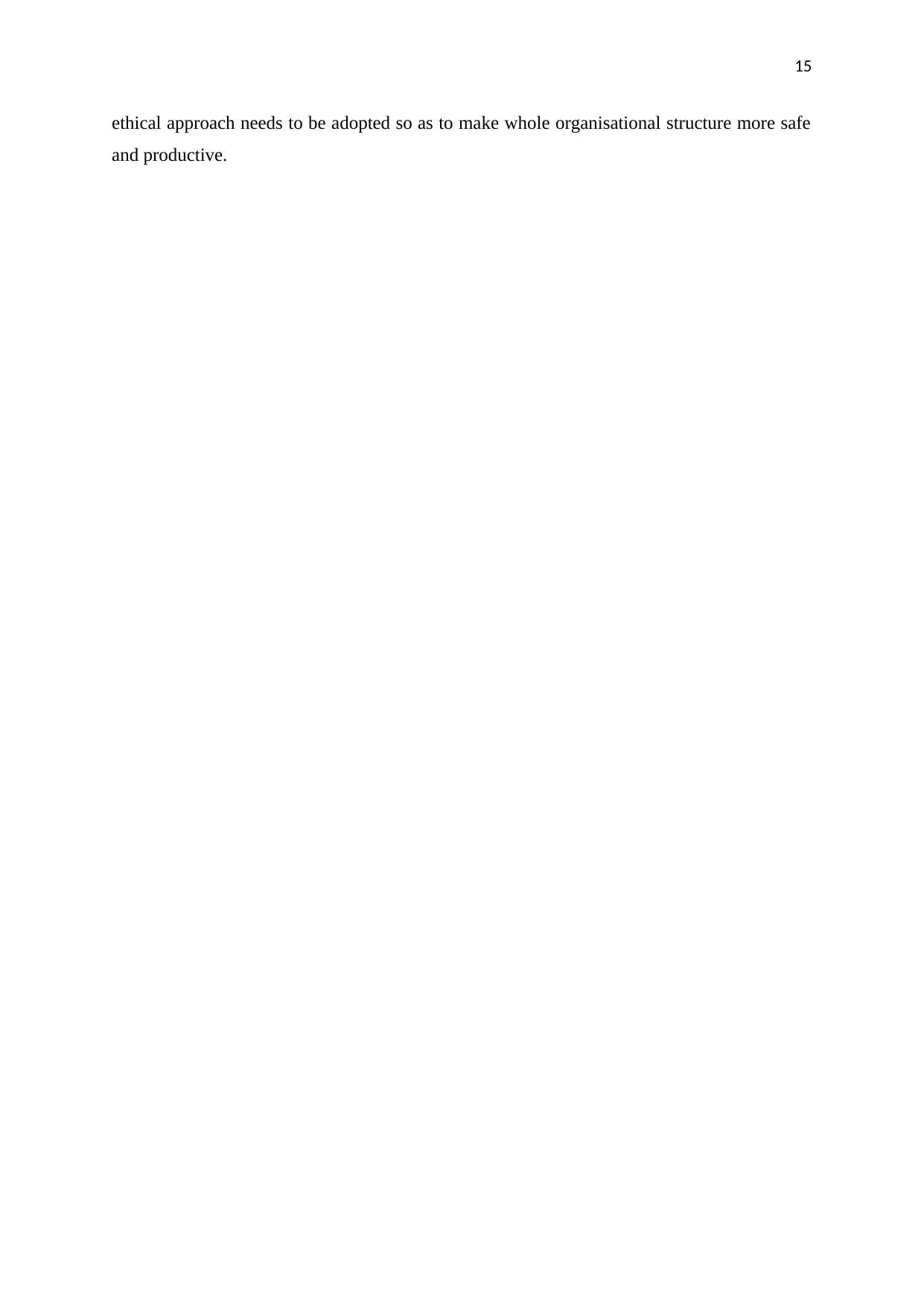
15
ethical approach needs to be adopted so as to make whole organisational structure more safe
and productive.
ethical approach needs to be adopted so as to make whole organisational structure more safe
and productive.
Secure Best Marks with AI Grader
Need help grading? Try our AI Grader for instant feedback on your assignments.

16
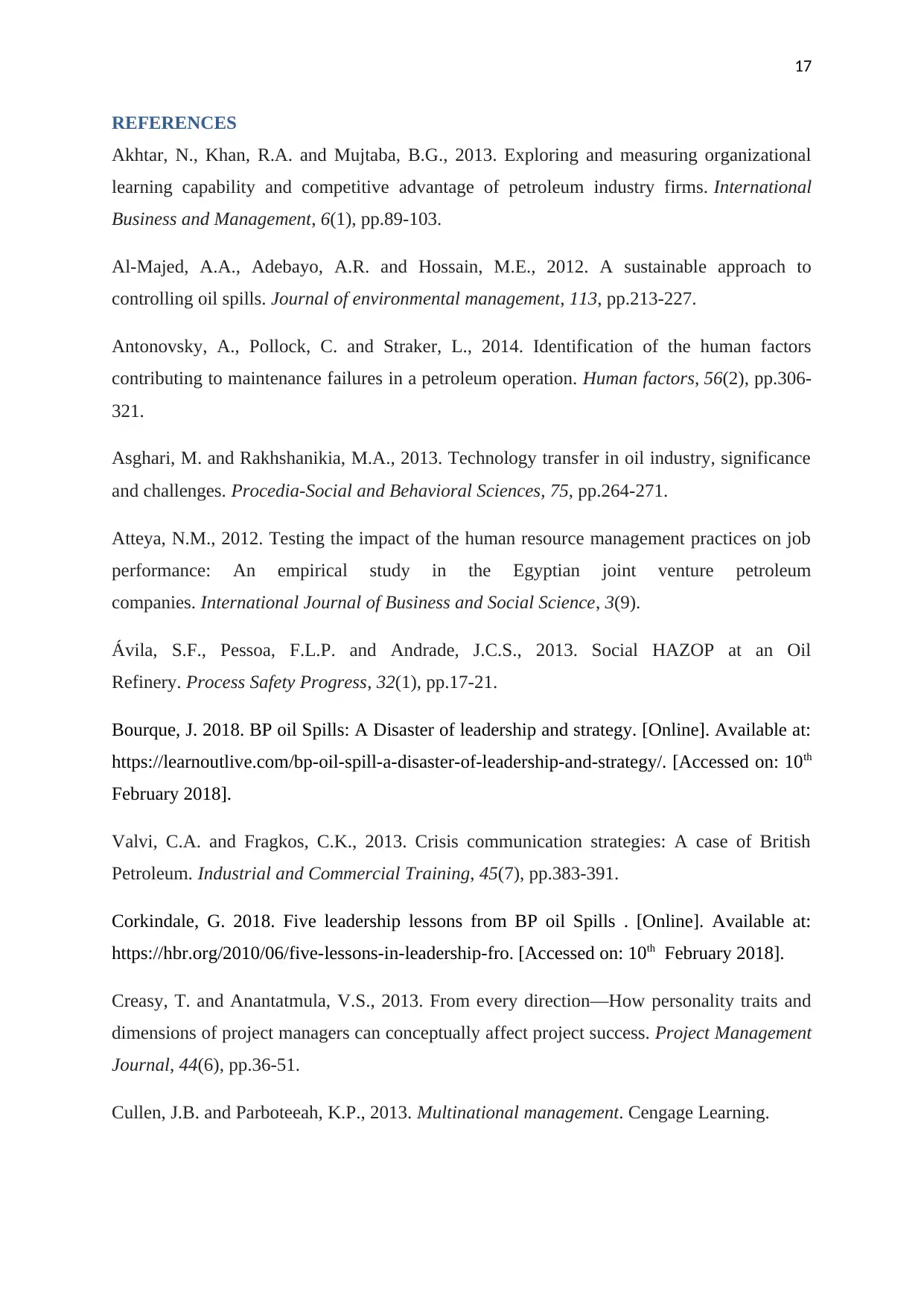
17
REFERENCES
Akhtar, N., Khan, R.A. and Mujtaba, B.G., 2013. Exploring and measuring organizational
learning capability and competitive advantage of petroleum industry firms. International
Business and Management, 6(1), pp.89-103.
Al-Majed, A.A., Adebayo, A.R. and Hossain, M.E., 2012. A sustainable approach to
controlling oil spills. Journal of environmental management, 113, pp.213-227.
Antonovsky, A., Pollock, C. and Straker, L., 2014. Identification of the human factors
contributing to maintenance failures in a petroleum operation. Human factors, 56(2), pp.306-
321.
Asghari, M. and Rakhshanikia, M.A., 2013. Technology transfer in oil industry, significance
and challenges. Procedia-Social and Behavioral Sciences, 75, pp.264-271.
Atteya, N.M., 2012. Testing the impact of the human resource management practices on job
performance: An empirical study in the Egyptian joint venture petroleum
companies. International Journal of Business and Social Science, 3(9).
Ávila, S.F., Pessoa, F.L.P. and Andrade, J.C.S., 2013. Social HAZOP at an Oil
Refinery. Process Safety Progress, 32(1), pp.17-21.
Bourque, J. 2018. BP oil Spills: A Disaster of leadership and strategy. [Online]. Available at:
https://learnoutlive.com/bp-oil-spill-a-disaster-of-leadership-and-strategy/. [Accessed on: 10th
February 2018].
Valvi, C.A. and Fragkos, C.K., 2013. Crisis communication strategies: A case of British
Petroleum. Industrial and Commercial Training, 45(7), pp.383-391.
Corkindale, G. 2018. Five leadership lessons from BP oil Spills . [Online]. Available at:
https://hbr.org/2010/06/five-lessons-in-leadership-fro. [Accessed on: 10th February 2018].
Creasy, T. and Anantatmula, V.S., 2013. From every direction—How personality traits and
dimensions of project managers can conceptually affect project success. Project Management
Journal, 44(6), pp.36-51.
Cullen, J.B. and Parboteeah, K.P., 2013. Multinational management. Cengage Learning.
REFERENCES
Akhtar, N., Khan, R.A. and Mujtaba, B.G., 2013. Exploring and measuring organizational
learning capability and competitive advantage of petroleum industry firms. International
Business and Management, 6(1), pp.89-103.
Al-Majed, A.A., Adebayo, A.R. and Hossain, M.E., 2012. A sustainable approach to
controlling oil spills. Journal of environmental management, 113, pp.213-227.
Antonovsky, A., Pollock, C. and Straker, L., 2014. Identification of the human factors
contributing to maintenance failures in a petroleum operation. Human factors, 56(2), pp.306-
321.
Asghari, M. and Rakhshanikia, M.A., 2013. Technology transfer in oil industry, significance
and challenges. Procedia-Social and Behavioral Sciences, 75, pp.264-271.
Atteya, N.M., 2012. Testing the impact of the human resource management practices on job
performance: An empirical study in the Egyptian joint venture petroleum
companies. International Journal of Business and Social Science, 3(9).
Ávila, S.F., Pessoa, F.L.P. and Andrade, J.C.S., 2013. Social HAZOP at an Oil
Refinery. Process Safety Progress, 32(1), pp.17-21.
Bourque, J. 2018. BP oil Spills: A Disaster of leadership and strategy. [Online]. Available at:
https://learnoutlive.com/bp-oil-spill-a-disaster-of-leadership-and-strategy/. [Accessed on: 10th
February 2018].
Valvi, C.A. and Fragkos, C.K., 2013. Crisis communication strategies: A case of British
Petroleum. Industrial and Commercial Training, 45(7), pp.383-391.
Corkindale, G. 2018. Five leadership lessons from BP oil Spills . [Online]. Available at:
https://hbr.org/2010/06/five-lessons-in-leadership-fro. [Accessed on: 10th February 2018].
Creasy, T. and Anantatmula, V.S., 2013. From every direction—How personality traits and
dimensions of project managers can conceptually affect project success. Project Management
Journal, 44(6), pp.36-51.
Cullen, J.B. and Parboteeah, K.P., 2013. Multinational management. Cengage Learning.
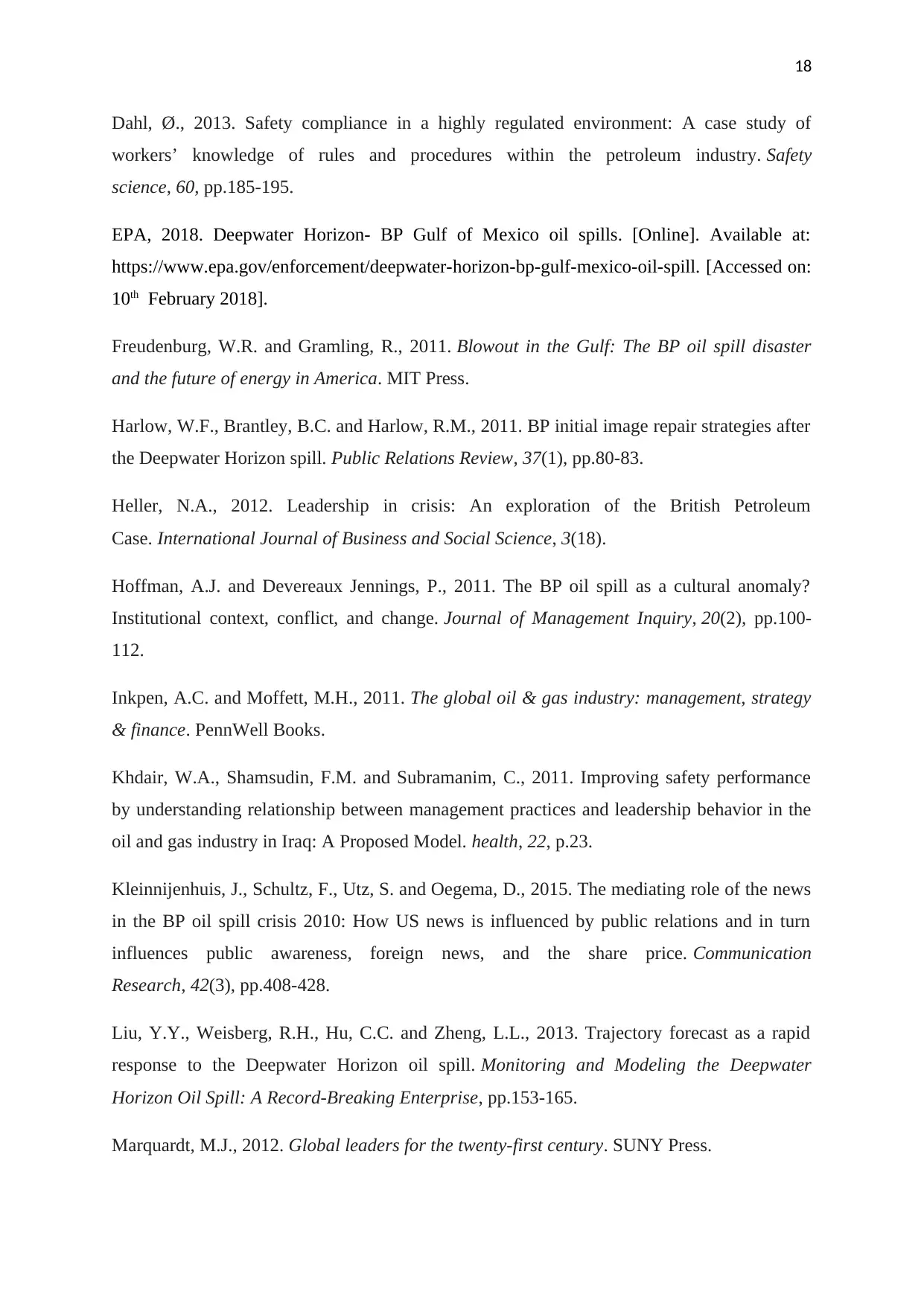
18
Dahl, Ø., 2013. Safety compliance in a highly regulated environment: A case study of
workers’ knowledge of rules and procedures within the petroleum industry. Safety
science, 60, pp.185-195.
EPA, 2018. Deepwater Horizon- BP Gulf of Mexico oil spills. [Online]. Available at:
https://www.epa.gov/enforcement/deepwater-horizon-bp-gulf-mexico-oil-spill. [Accessed on:
10th February 2018].
Freudenburg, W.R. and Gramling, R., 2011. Blowout in the Gulf: The BP oil spill disaster
and the future of energy in America. MIT Press.
Harlow, W.F., Brantley, B.C. and Harlow, R.M., 2011. BP initial image repair strategies after
the Deepwater Horizon spill. Public Relations Review, 37(1), pp.80-83.
Heller, N.A., 2012. Leadership in crisis: An exploration of the British Petroleum
Case. International Journal of Business and Social Science, 3(18).
Hoffman, A.J. and Devereaux Jennings, P., 2011. The BP oil spill as a cultural anomaly?
Institutional context, conflict, and change. Journal of Management Inquiry, 20(2), pp.100-
112.
Inkpen, A.C. and Moffett, M.H., 2011. The global oil & gas industry: management, strategy
& finance. PennWell Books.
Khdair, W.A., Shamsudin, F.M. and Subramanim, C., 2011. Improving safety performance
by understanding relationship between management practices and leadership behavior in the
oil and gas industry in Iraq: A Proposed Model. health, 22, p.23.
Kleinnijenhuis, J., Schultz, F., Utz, S. and Oegema, D., 2015. The mediating role of the news
in the BP oil spill crisis 2010: How US news is influenced by public relations and in turn
influences public awareness, foreign news, and the share price. Communication
Research, 42(3), pp.408-428.
Liu, Y.Y., Weisberg, R.H., Hu, C.C. and Zheng, L.L., 2013. Trajectory forecast as a rapid
response to the Deepwater Horizon oil spill. Monitoring and Modeling the Deepwater
Horizon Oil Spill: A Record-Breaking Enterprise, pp.153-165.
Marquardt, M.J., 2012. Global leaders for the twenty-first century. SUNY Press.
Dahl, Ø., 2013. Safety compliance in a highly regulated environment: A case study of
workers’ knowledge of rules and procedures within the petroleum industry. Safety
science, 60, pp.185-195.
EPA, 2018. Deepwater Horizon- BP Gulf of Mexico oil spills. [Online]. Available at:
https://www.epa.gov/enforcement/deepwater-horizon-bp-gulf-mexico-oil-spill. [Accessed on:
10th February 2018].
Freudenburg, W.R. and Gramling, R., 2011. Blowout in the Gulf: The BP oil spill disaster
and the future of energy in America. MIT Press.
Harlow, W.F., Brantley, B.C. and Harlow, R.M., 2011. BP initial image repair strategies after
the Deepwater Horizon spill. Public Relations Review, 37(1), pp.80-83.
Heller, N.A., 2012. Leadership in crisis: An exploration of the British Petroleum
Case. International Journal of Business and Social Science, 3(18).
Hoffman, A.J. and Devereaux Jennings, P., 2011. The BP oil spill as a cultural anomaly?
Institutional context, conflict, and change. Journal of Management Inquiry, 20(2), pp.100-
112.
Inkpen, A.C. and Moffett, M.H., 2011. The global oil & gas industry: management, strategy
& finance. PennWell Books.
Khdair, W.A., Shamsudin, F.M. and Subramanim, C., 2011. Improving safety performance
by understanding relationship between management practices and leadership behavior in the
oil and gas industry in Iraq: A Proposed Model. health, 22, p.23.
Kleinnijenhuis, J., Schultz, F., Utz, S. and Oegema, D., 2015. The mediating role of the news
in the BP oil spill crisis 2010: How US news is influenced by public relations and in turn
influences public awareness, foreign news, and the share price. Communication
Research, 42(3), pp.408-428.
Liu, Y.Y., Weisberg, R.H., Hu, C.C. and Zheng, L.L., 2013. Trajectory forecast as a rapid
response to the Deepwater Horizon oil spill. Monitoring and Modeling the Deepwater
Horizon Oil Spill: A Record-Breaking Enterprise, pp.153-165.
Marquardt, M.J., 2012. Global leaders for the twenty-first century. SUNY Press.
Paraphrase This Document
Need a fresh take? Get an instant paraphrase of this document with our AI Paraphraser
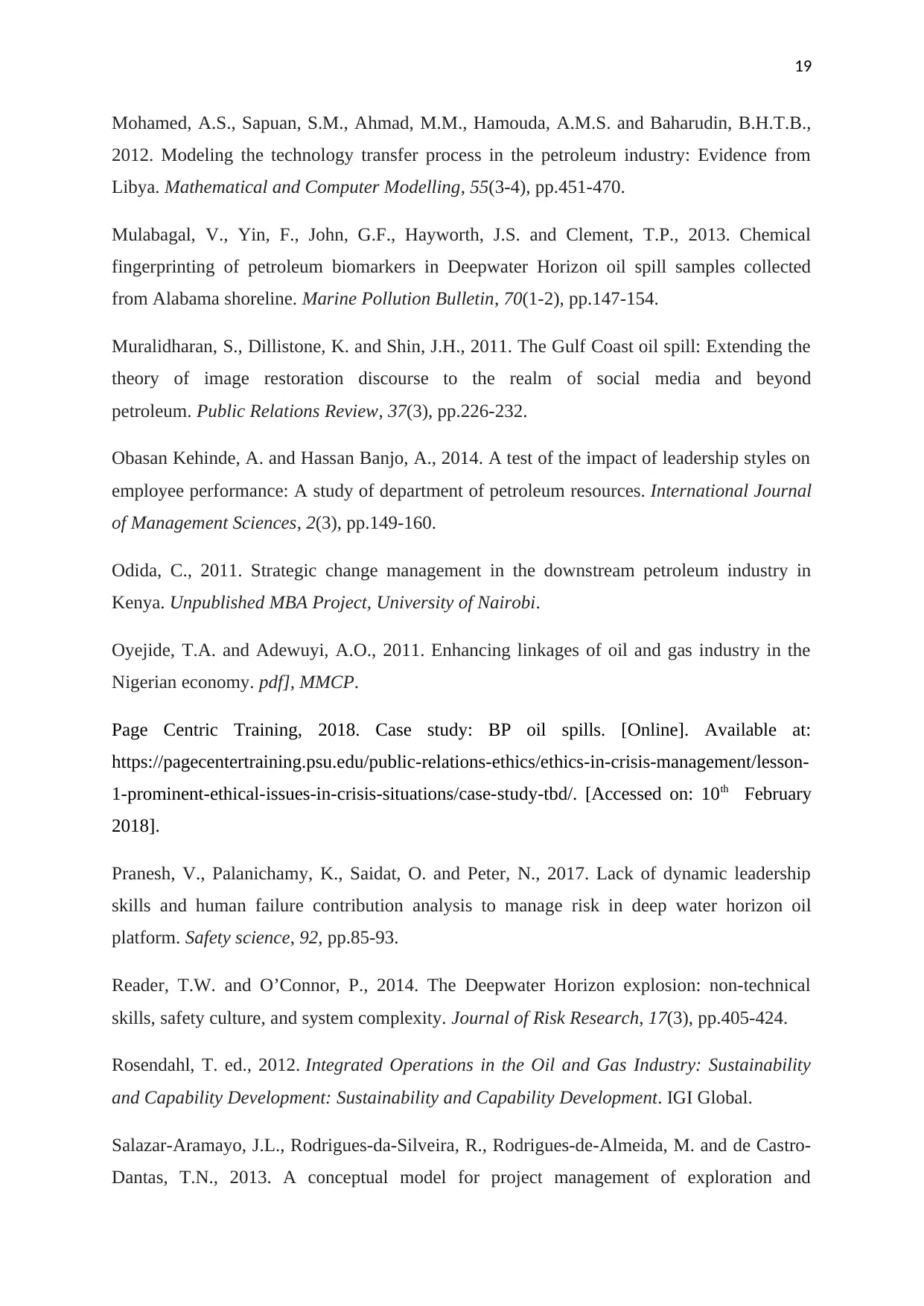
19
Mohamed, A.S., Sapuan, S.M., Ahmad, M.M., Hamouda, A.M.S. and Baharudin, B.H.T.B.,
2012. Modeling the technology transfer process in the petroleum industry: Evidence from
Libya. Mathematical and Computer Modelling, 55(3-4), pp.451-470.
Mulabagal, V., Yin, F., John, G.F., Hayworth, J.S. and Clement, T.P., 2013. Chemical
fingerprinting of petroleum biomarkers in Deepwater Horizon oil spill samples collected
from Alabama shoreline. Marine Pollution Bulletin, 70(1-2), pp.147-154.
Muralidharan, S., Dillistone, K. and Shin, J.H., 2011. The Gulf Coast oil spill: Extending the
theory of image restoration discourse to the realm of social media and beyond
petroleum. Public Relations Review, 37(3), pp.226-232.
Obasan Kehinde, A. and Hassan Banjo, A., 2014. A test of the impact of leadership styles on
employee performance: A study of department of petroleum resources. International Journal
of Management Sciences, 2(3), pp.149-160.
Odida, C., 2011. Strategic change management in the downstream petroleum industry in
Kenya. Unpublished MBA Project, University of Nairobi.
Oyejide, T.A. and Adewuyi, A.O., 2011. Enhancing linkages of oil and gas industry in the
Nigerian economy. pdf], MMCP.
Page Centric Training, 2018. Case study: BP oil spills. [Online]. Available at:
https://pagecentertraining.psu.edu/public-relations-ethics/ethics-in-crisis-management/lesson-
1-prominent-ethical-issues-in-crisis-situations/case-study-tbd/. [Accessed on: 10th February
2018].
Pranesh, V., Palanichamy, K., Saidat, O. and Peter, N., 2017. Lack of dynamic leadership
skills and human failure contribution analysis to manage risk in deep water horizon oil
platform. Safety science, 92, pp.85-93.
Reader, T.W. and O’Connor, P., 2014. The Deepwater Horizon explosion: non-technical
skills, safety culture, and system complexity. Journal of Risk Research, 17(3), pp.405-424.
Rosendahl, T. ed., 2012. Integrated Operations in the Oil and Gas Industry: Sustainability
and Capability Development: Sustainability and Capability Development. IGI Global.
Salazar-Aramayo, J.L., Rodrigues-da-Silveira, R., Rodrigues-de-Almeida, M. and de Castro-
Dantas, T.N., 2013. A conceptual model for project management of exploration and
Mohamed, A.S., Sapuan, S.M., Ahmad, M.M., Hamouda, A.M.S. and Baharudin, B.H.T.B.,
2012. Modeling the technology transfer process in the petroleum industry: Evidence from
Libya. Mathematical and Computer Modelling, 55(3-4), pp.451-470.
Mulabagal, V., Yin, F., John, G.F., Hayworth, J.S. and Clement, T.P., 2013. Chemical
fingerprinting of petroleum biomarkers in Deepwater Horizon oil spill samples collected
from Alabama shoreline. Marine Pollution Bulletin, 70(1-2), pp.147-154.
Muralidharan, S., Dillistone, K. and Shin, J.H., 2011. The Gulf Coast oil spill: Extending the
theory of image restoration discourse to the realm of social media and beyond
petroleum. Public Relations Review, 37(3), pp.226-232.
Obasan Kehinde, A. and Hassan Banjo, A., 2014. A test of the impact of leadership styles on
employee performance: A study of department of petroleum resources. International Journal
of Management Sciences, 2(3), pp.149-160.
Odida, C., 2011. Strategic change management in the downstream petroleum industry in
Kenya. Unpublished MBA Project, University of Nairobi.
Oyejide, T.A. and Adewuyi, A.O., 2011. Enhancing linkages of oil and gas industry in the
Nigerian economy. pdf], MMCP.
Page Centric Training, 2018. Case study: BP oil spills. [Online]. Available at:
https://pagecentertraining.psu.edu/public-relations-ethics/ethics-in-crisis-management/lesson-
1-prominent-ethical-issues-in-crisis-situations/case-study-tbd/. [Accessed on: 10th February
2018].
Pranesh, V., Palanichamy, K., Saidat, O. and Peter, N., 2017. Lack of dynamic leadership
skills and human failure contribution analysis to manage risk in deep water horizon oil
platform. Safety science, 92, pp.85-93.
Reader, T.W. and O’Connor, P., 2014. The Deepwater Horizon explosion: non-technical
skills, safety culture, and system complexity. Journal of Risk Research, 17(3), pp.405-424.
Rosendahl, T. ed., 2012. Integrated Operations in the Oil and Gas Industry: Sustainability
and Capability Development: Sustainability and Capability Development. IGI Global.
Salazar-Aramayo, J.L., Rodrigues-da-Silveira, R., Rodrigues-de-Almeida, M. and de Castro-
Dantas, T.N., 2013. A conceptual model for project management of exploration and
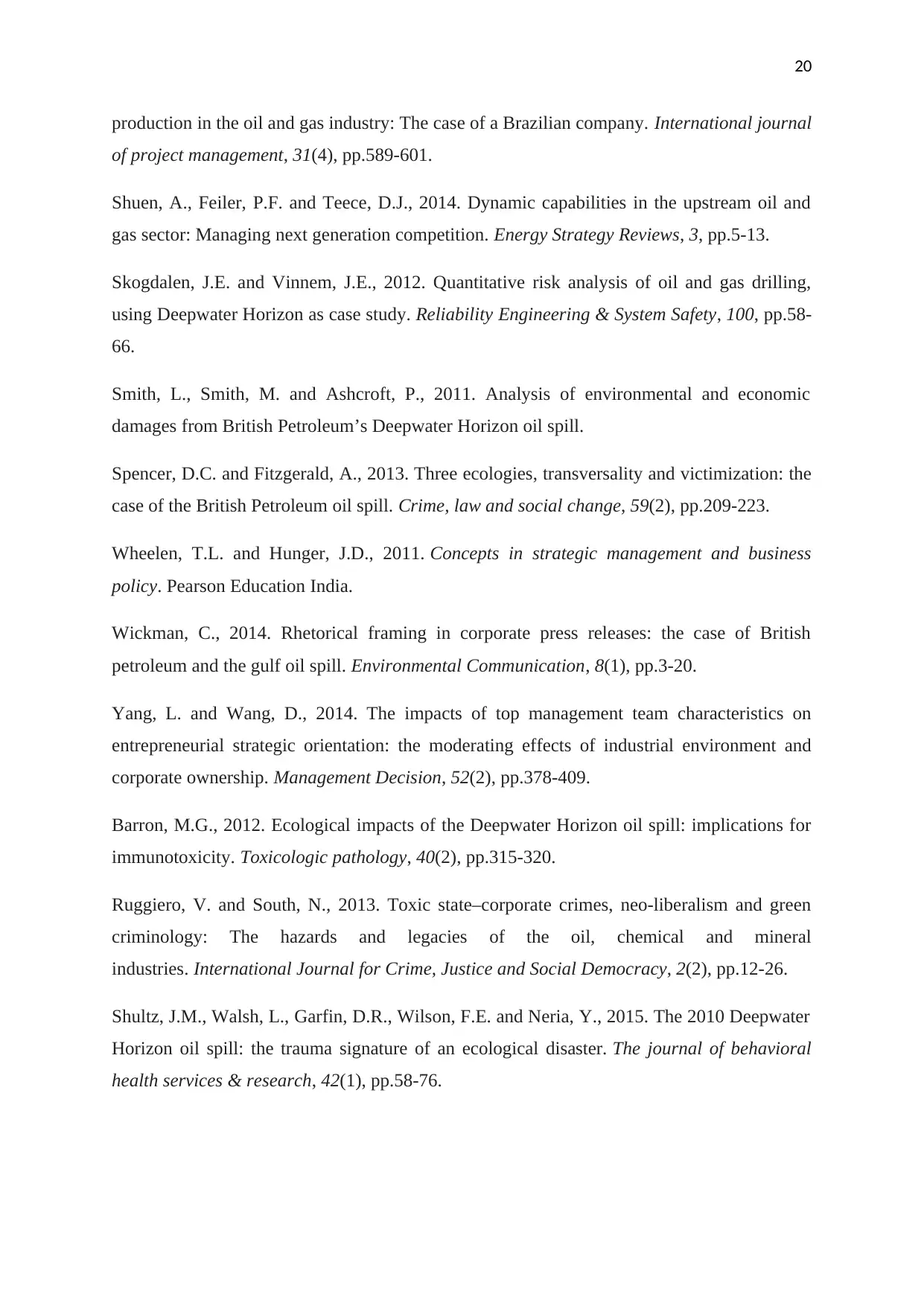
20
production in the oil and gas industry: The case of a Brazilian company. International journal
of project management, 31(4), pp.589-601.
Shuen, A., Feiler, P.F. and Teece, D.J., 2014. Dynamic capabilities in the upstream oil and
gas sector: Managing next generation competition. Energy Strategy Reviews, 3, pp.5-13.
Skogdalen, J.E. and Vinnem, J.E., 2012. Quantitative risk analysis of oil and gas drilling,
using Deepwater Horizon as case study. Reliability Engineering & System Safety, 100, pp.58-
66.
Smith, L., Smith, M. and Ashcroft, P., 2011. Analysis of environmental and economic
damages from British Petroleum’s Deepwater Horizon oil spill.
Spencer, D.C. and Fitzgerald, A., 2013. Three ecologies, transversality and victimization: the
case of the British Petroleum oil spill. Crime, law and social change, 59(2), pp.209-223.
Wheelen, T.L. and Hunger, J.D., 2011. Concepts in strategic management and business
policy. Pearson Education India.
Wickman, C., 2014. Rhetorical framing in corporate press releases: the case of British
petroleum and the gulf oil spill. Environmental Communication, 8(1), pp.3-20.
Yang, L. and Wang, D., 2014. The impacts of top management team characteristics on
entrepreneurial strategic orientation: the moderating effects of industrial environment and
corporate ownership. Management Decision, 52(2), pp.378-409.
Barron, M.G., 2012. Ecological impacts of the Deepwater Horizon oil spill: implications for
immunotoxicity. Toxicologic pathology, 40(2), pp.315-320.
Ruggiero, V. and South, N., 2013. Toxic state–corporate crimes, neo-liberalism and green
criminology: The hazards and legacies of the oil, chemical and mineral
industries. International Journal for Crime, Justice and Social Democracy, 2(2), pp.12-26.
Shultz, J.M., Walsh, L., Garfin, D.R., Wilson, F.E. and Neria, Y., 2015. The 2010 Deepwater
Horizon oil spill: the trauma signature of an ecological disaster. The journal of behavioral
health services & research, 42(1), pp.58-76.
production in the oil and gas industry: The case of a Brazilian company. International journal
of project management, 31(4), pp.589-601.
Shuen, A., Feiler, P.F. and Teece, D.J., 2014. Dynamic capabilities in the upstream oil and
gas sector: Managing next generation competition. Energy Strategy Reviews, 3, pp.5-13.
Skogdalen, J.E. and Vinnem, J.E., 2012. Quantitative risk analysis of oil and gas drilling,
using Deepwater Horizon as case study. Reliability Engineering & System Safety, 100, pp.58-
66.
Smith, L., Smith, M. and Ashcroft, P., 2011. Analysis of environmental and economic
damages from British Petroleum’s Deepwater Horizon oil spill.
Spencer, D.C. and Fitzgerald, A., 2013. Three ecologies, transversality and victimization: the
case of the British Petroleum oil spill. Crime, law and social change, 59(2), pp.209-223.
Wheelen, T.L. and Hunger, J.D., 2011. Concepts in strategic management and business
policy. Pearson Education India.
Wickman, C., 2014. Rhetorical framing in corporate press releases: the case of British
petroleum and the gulf oil spill. Environmental Communication, 8(1), pp.3-20.
Yang, L. and Wang, D., 2014. The impacts of top management team characteristics on
entrepreneurial strategic orientation: the moderating effects of industrial environment and
corporate ownership. Management Decision, 52(2), pp.378-409.
Barron, M.G., 2012. Ecological impacts of the Deepwater Horizon oil spill: implications for
immunotoxicity. Toxicologic pathology, 40(2), pp.315-320.
Ruggiero, V. and South, N., 2013. Toxic state–corporate crimes, neo-liberalism and green
criminology: The hazards and legacies of the oil, chemical and mineral
industries. International Journal for Crime, Justice and Social Democracy, 2(2), pp.12-26.
Shultz, J.M., Walsh, L., Garfin, D.R., Wilson, F.E. and Neria, Y., 2015. The 2010 Deepwater
Horizon oil spill: the trauma signature of an ecological disaster. The journal of behavioral
health services & research, 42(1), pp.58-76.
1 out of 21
Related Documents
Your All-in-One AI-Powered Toolkit for Academic Success.
+13062052269
info@desklib.com
Available 24*7 on WhatsApp / Email
![[object Object]](/_next/static/media/star-bottom.7253800d.svg)
Unlock your academic potential
© 2024 | Zucol Services PVT LTD | All rights reserved.





